Cabo Verde is an archipelago nation located in the Atlantic Ocean, off the coast of northwest Africa. This collection of islands is home to a diverse range of birds, which have adapted to the unique conditions of the archipelago.
From the endemic species found only in Cabo Verde, to the migratory species that use the islands as a stopping point during their long journeys, the birds of Cabo Verde are an important part of the local ecology and culture. This introduction will provide an overview of the birds of Cabo Verde, their habitats, and the conservation efforts that are helping to protect them.
1. Iago Sparrow
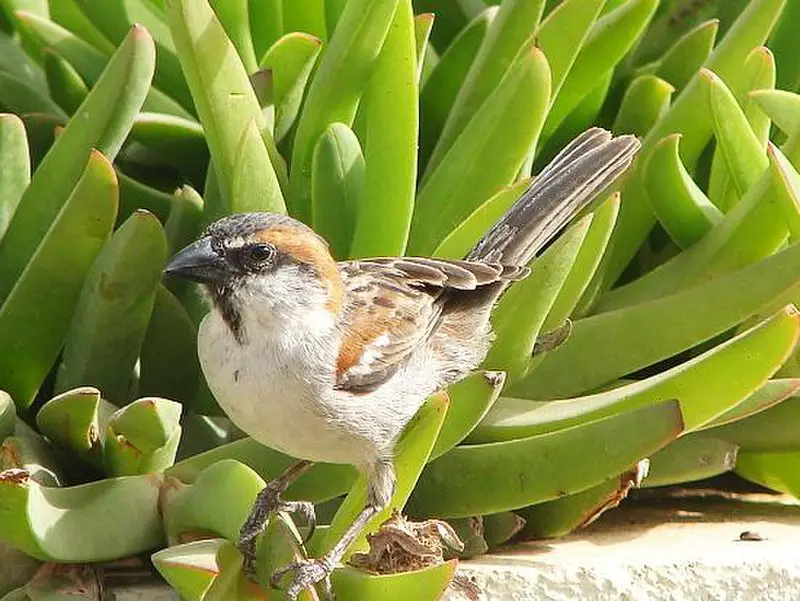
The Iago sparrow is a small and unique passerine bird belonging to the sparrow family Passeridae. It is endemic to the Cape Verde archipelago in western Africa, close to the eastern Atlantic Ocean.
Females and young birds have brown plumage with black marks above, as well as dull grey undersides – distinguishing them from other species of sparrows.
Males are recognised by their light coloured breasts along with reddish-brown backs which gives them its nickname ‘rufous-backed’ or ‘Cape Verde’.
They feed on insects and seeds found on low shrubs around semi-desert areas such as mountain slopes or sand dunes within these islands.
The Iago Sparrow remains an endangered species due to human disturbance leading towards habitat destruction as well overgrazing of livestock animals among others factors that threaten this precious bird’s survival rate in its natural environment.
Scientific classification:
| Kingdom | Animalia |
| Phylum | Chordata |
| Class | Aves |
| Order | Passeriformes |
| Family | Passeridae |
| Genus | Passer |
| Species | P. iagoensis |
2. Cape Verde Shearwater
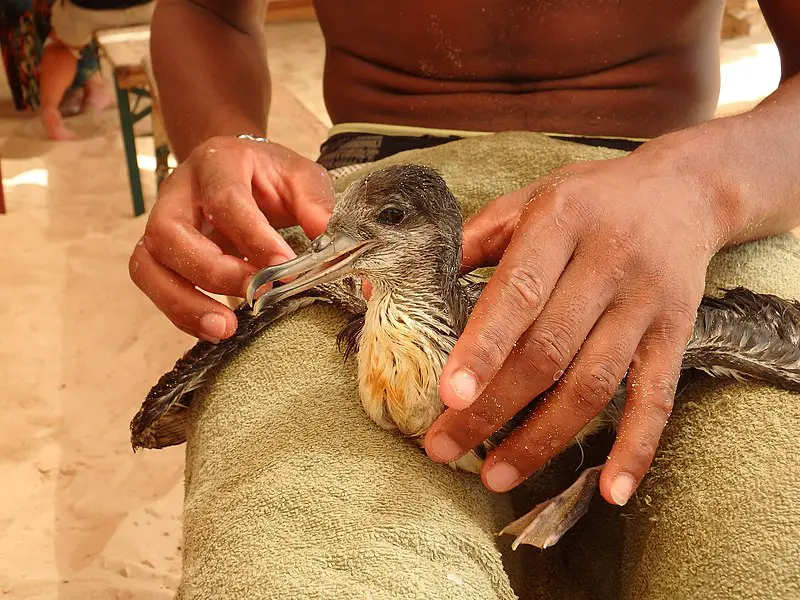
The Cape Verde shearwater is a unique bird found only in the Macaronesia archipelago of the Atlantic Ocean, off West Africa.
It belongs to the petrel family Procellariidae and was first described by Émile Oustalet in 1883 as its own species.
This medium-large seabird has been known locally as cagarra for centuries due to its distinctive call heard during breeding season.
Its plumage varies from greyish brown above and white below with some lighter feathers on their head, neck and underparts which gives them an overall pale appearance when seen at sea level.
The Cape Verde Shearwater is vulnerable due to human activities such as fishing nets that can trap these birds along with commercial egg collecting which affects their population size significantly.
Conservation efforts are necessary in order to ensure this beautiful creature survives into future generations.
Scientific classification:
| Kingdom | Animalia |
| Phylum | Chordata |
| Class | Aves |
| Order | Procellariiformes |
| Family | Procellariidae |
| Genus | Calonectris |
| Species | C. edwardsii |
3. Raso Lark
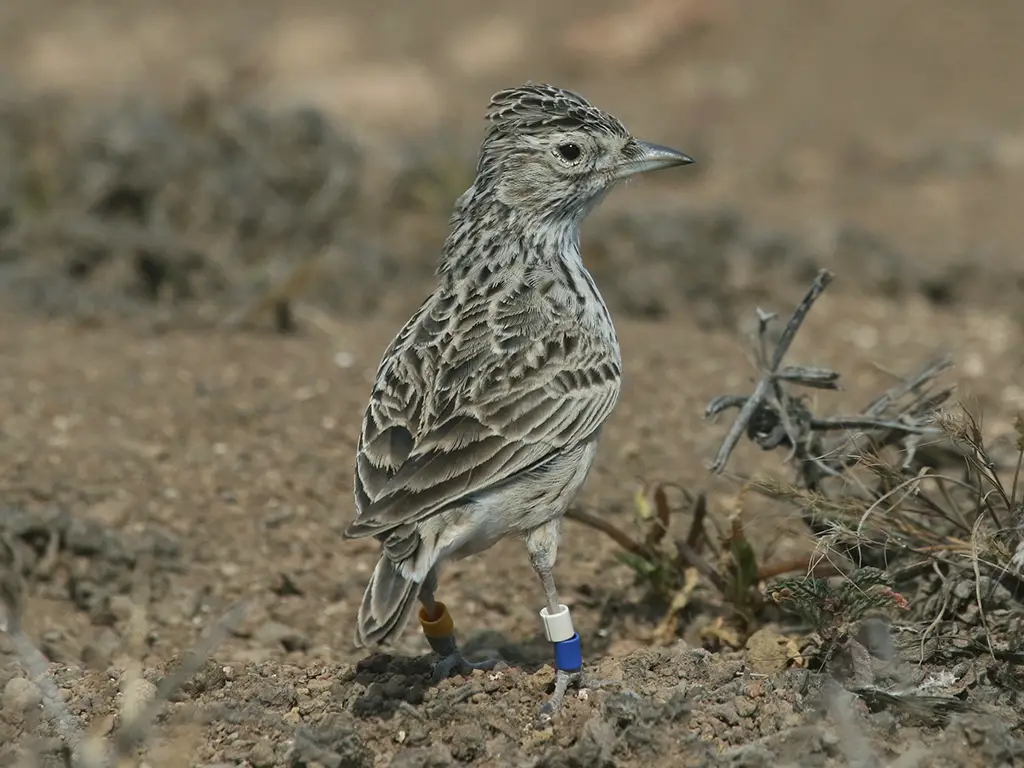
Raso Lark is a small passerine bird that can only be found on the Raso Islet in Cape Verde Islands. It has been classified as critically endangered due to its limited range and lack of research data.
The dry terrain makes it difficult for researchers to study this species, making it one of the least known birds in Western Palaearctic region.
Its diet mainly consists of insects which are hunted by hovering over sparse vegetation or bare ground and then flying down to catch them midair.
They make their nests near bushes at low elevations where they also lay their eggs and take care of chicks until they fledge successfully.
Conservation efforts must be taken now so we don’t lose such an important part of our ecosystem before there’s no hope left.
Scientific classification:
| Kingdom | Animalia |
| Phylum | Chordata |
| Class | Aves |
| Order | Passeriformes |
| Family | Alaudidae |
| Genus | Alauda |
| Species | A. razae |
4. Procellariidae
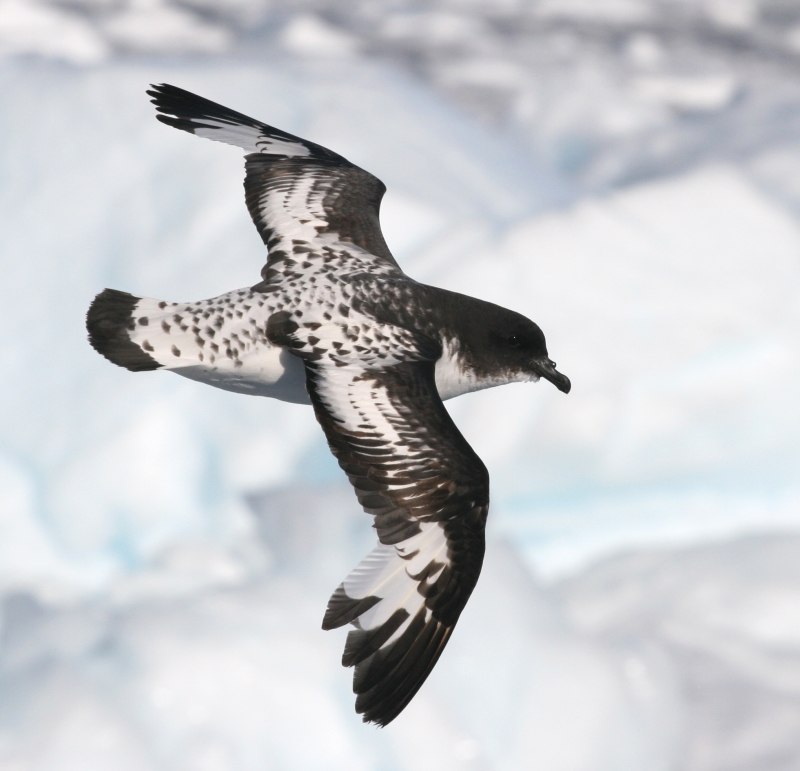
Procellariidae is a diverse family of seabirds belonging to the bird order Procellariiformes.
These birds are commonly referred to as tubenoses and include fulmarine petrels, gadfly petrels, diving petrels, prions, and shearwaters.
They range in size from the small storm-petrel which measures around 18cm long to the giant albatross which can reach up to 3 meters in length.
Generally found near oceans or coasts where they feed on fish as well as squid and other marine life depending on species.
Many procellariids will also nest inland during breeding season before returning back out at sea for most of their lives.
Their wings have specially adapted feathers that give them incredible gliding abilities allowing them literally fly with minimal effort over vast distances across oceanic regions.
Scientific classification:
| Kingdom | Animalia |
| Phylum | Chordata |
| Class | Aves |
| Order | Procellariiformes |
| Family | Procellariidae Leach, 1820 |
5. Fea’s Petrel
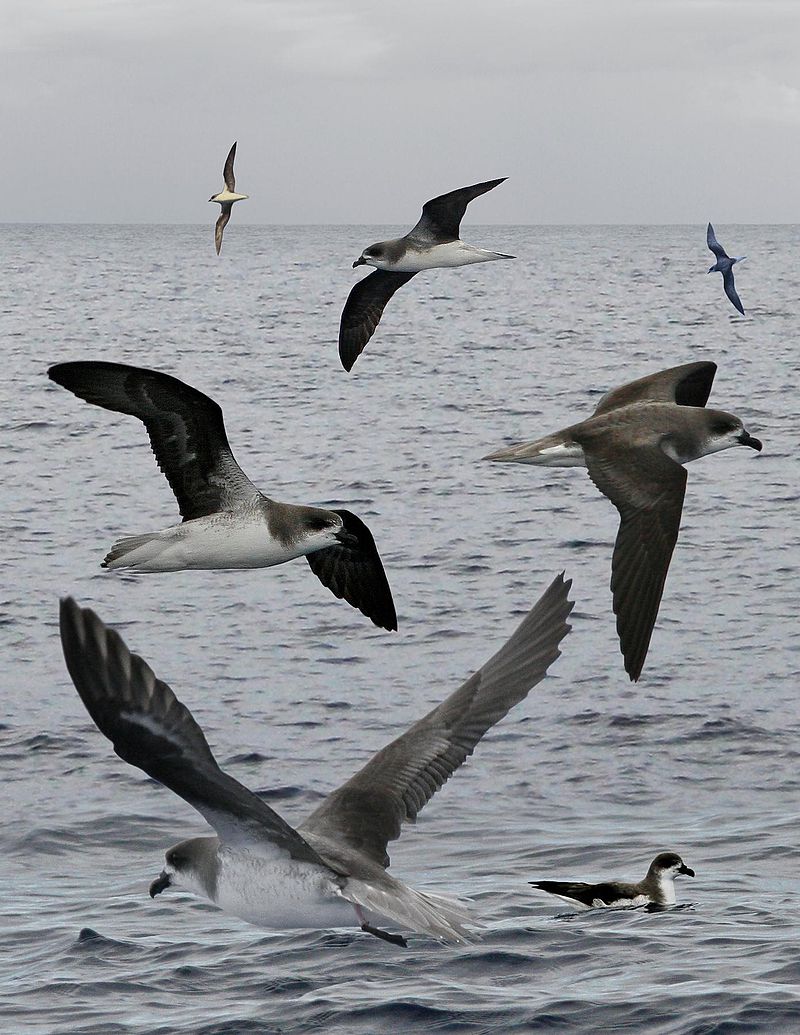
The Fea’s petrel is a small seabird in the family of gadfly petrels. It was previously thought to be related to the soft-plumaged petrel, but recent research has proven that they are actually not closely connected at all.
This species is however very closely linked with Zino’s and Desertas Petrel – two other birds recently split from Pterodroma mollis.
Gadfly Petrels get their name due to their erratic flight pattern which looks similar to a flying insect like a fly or moth.
They can often be seen gliding along above oceans and across islands, searching for food such as fish or squid just beneath the surface of the water below them.
The striking black colouration on top combined with white undersides make it easy to identify these beautiful creatures when out in nature.
Scientific classification:
| Kingdom | Animalia |
| Phylum | Chordata |
| Class | Aves |
| Order | Procellariiformes |
| Family | Procellariidae |
| Genus | Pterodroma |
| Species | P. feae |
6. Red-Billed Tropicbird
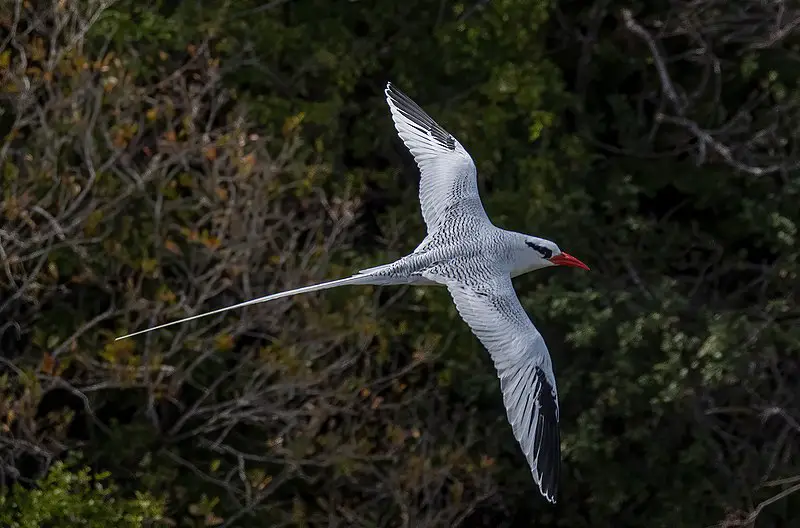
The Red-billed Tropicbird is a beautiful seabird found in tropical oceans. It has mainly white plumage, with black markings on its wings and back, along with a black mask and red bill.
These birds have distinctive long tail streamers that are twice their body length which they use to help them soar above the ocean surface while searching for food.
They primarily feed off squid, fish and crustaceans that inhabit coral reefs or deep sea areas where they can dive up to 30 meters below the water’s surface.
The Red-billed Tropicbird was once thought of as an omen of bad luck but now it serves as a reminder of how delicate our marine ecosystems are when faced with human activity such as overfishing.
Scientific classification:
| Kingdom | Animalia |
| Phylum | Chordata |
| Class | Aves |
| Order | Phaethontiformes |
| Family | Phaethontidae |
| Genus | Phaethon |
| Species | P. aethereus |
7. Cape Verde Swift
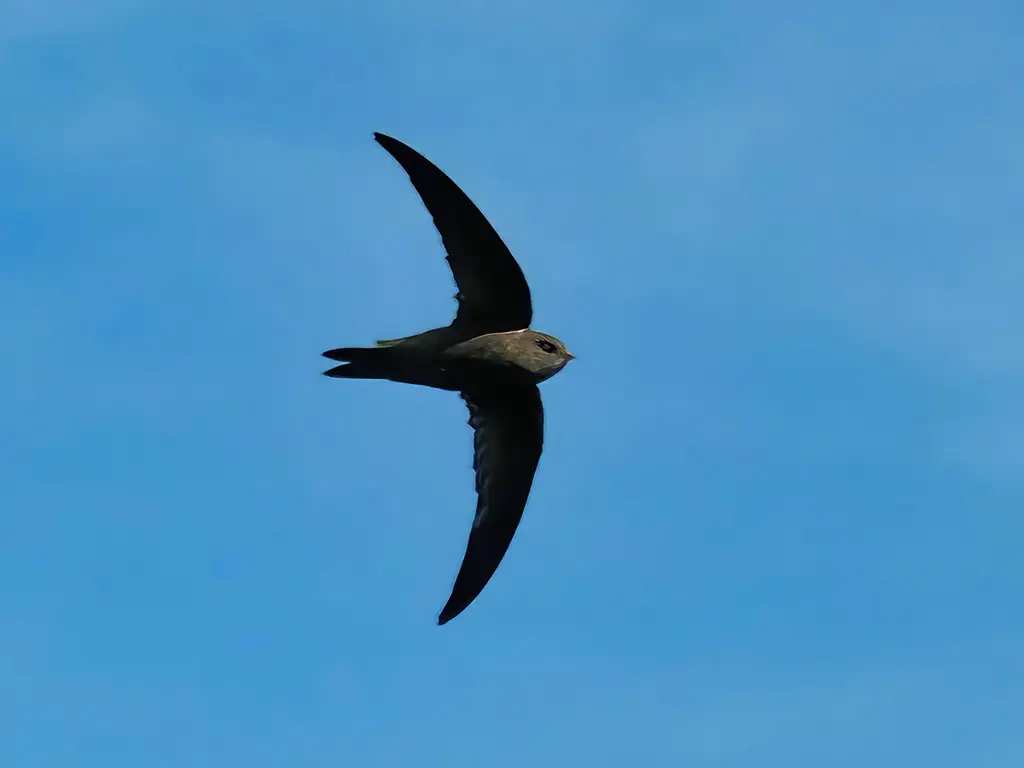
Cape Verde swift, also known as Alexander’s swift, is a small bird of the swif family found only in the Cape Verde Islands.
It can be seen across all islands except Santa Luzia, with its main breeding grounds being Santiago, Fogo Brava Santo Antão and São Nicolau.
This species has a stable population and is not under threat at present time.
The birds have an overall dark brownish grey colouration on their back while having white underneaths which allow them to be easily spotted from below when flying around above ground level searching for food such as insects or other arthropods – their primary source of nutrition.
Scientific classification:
| Kingdom | Animalia |
| Phylum | Chordata |
| Class | Aves |
| Order | Apodiformes |
| Family | Apodidae |
| Genus | Apus |
| Species | A. alexandri |
8. Common Waxbill
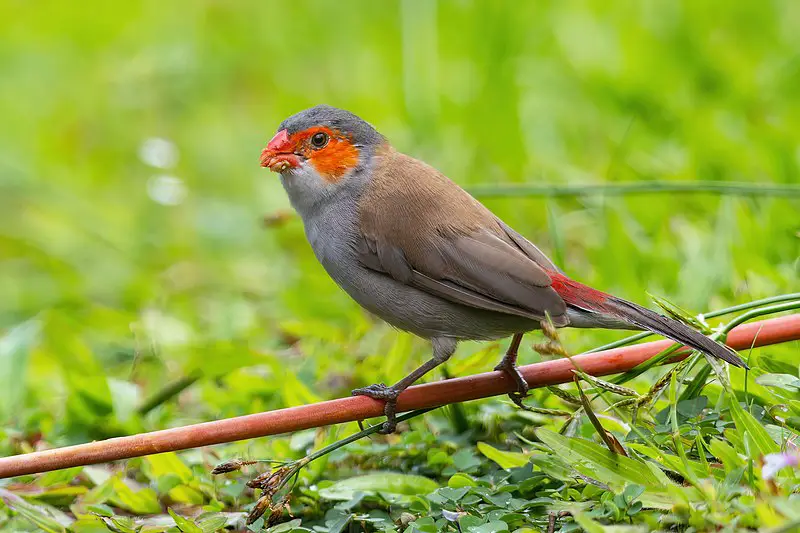
The Common Waxbill is a beautiful small passerine bird native to sub-Saharan Africa.
It has become popular in captivity and can be found all over the world, with an estimated global extent of occurrence of 10 million km2.
Its formal description was provided by Carl Linnaeus in 1758 as part of his Systema Naturae; he gave it the scientific name Estrilda astrild.
This species is mainly greyish brown or olive green on its upperparts while having chestnut colored wings and tail feathers which are tipped with white or creamy yellow.
They have red eyes, pink bills and legs, giving them an overall attractive appearance.
The Common waxbill feeds primarily on grass seeds but also takes insects occasionally when available. It breeds readily in aviaries making it a great choice for avid bird keepers.
Scientific classification:
| Kingdom | Animalia |
| Phylum | Chordata |
| Class | Aves |
| Order | Passeriformes |
| Family | Estrildidae |
| Genus | Estrilda |
| Species | E. astrild |
9. Accipitridae
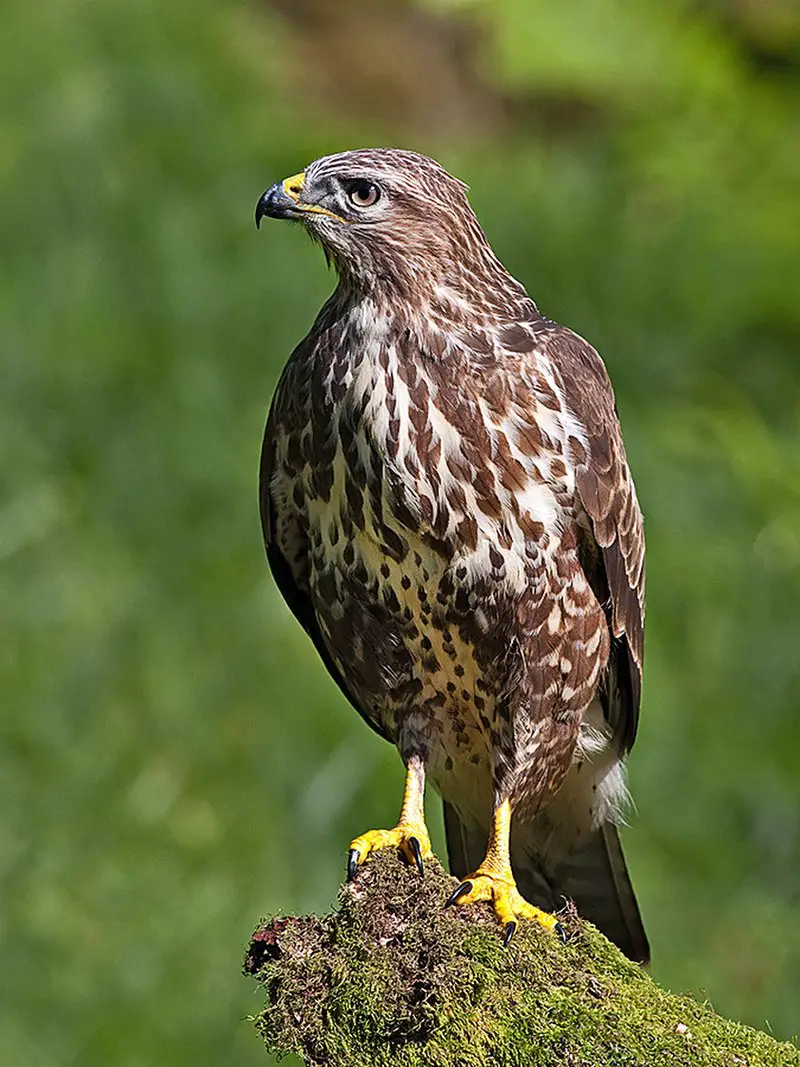
Accipitridae birds are a diverse family of raptors ranging in size from small to large. They have powerful hooked beaks which they use for hunting and tearing apart their prey, such as insects, medium-sized mammals and carrion.
Some species even feed on fruit. These birds can be found all over the world, making them an incredibly successful group of predators.
Accipitridae are adaptable hunters with keen eyesight that helps them spot potential meals from far away distances.
Their sharp talons assist them in grasping onto their victims while feeding or defending themselves against enemies.
Not only do these avian creatures provide us with visual beauty but also help keep our ecosystems healthy by keeping pest populations under control.
Scientific classification:
| Kingdom | Animalia |
| Phylum | Chordata |
| Class | Aves |
| Order | Accipitriformes |
| Family | Accipitridae Vieillot, 1816 |
10. Northern Storm Petrels
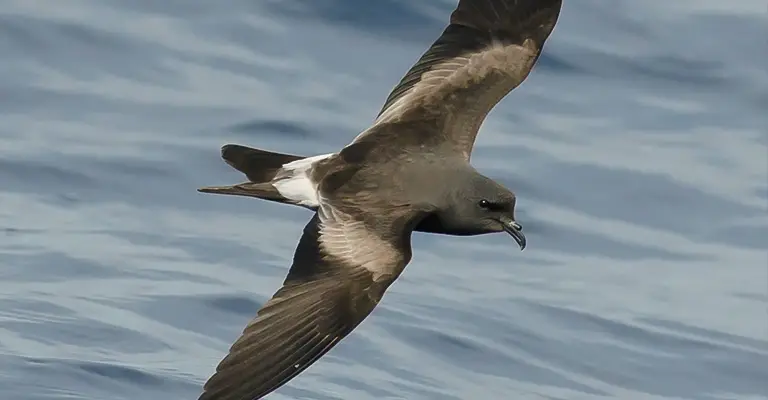
Northern storm petrels are one of the smallest seabirds, inhabiting oceans all over the world.
They have a unique ability to hover over water and pick planktonic crustaceans and small fish from the surface.
Northern storm petrels belong to the genus Hydrobates in family Hydrobatidae, part of Procellariiformes order.
This species was once lumped with austral storm petrel but recent studies show that they weren’t related closely which led them being split into two distinct species now.
These birds can be identified by their dark grey upperparts and wings along with white underparts when seen from afar while feeding on ocean’s surface.
Scientific classification:
| Kingdom | Animalia |
| Phylum | Chordata |
| Class | Aves |
| Order | Procellariiformes |
| Family | Hydrobatidae Mathews, 1912 |
| Genus | Hydrobates F. Boie, 1822 |
11. Magnificent Frigatebird
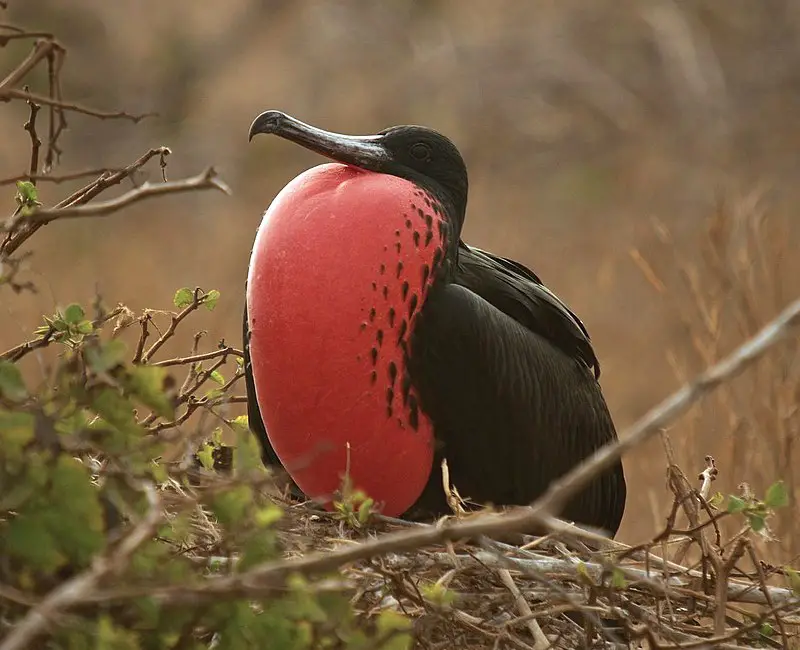
The Magnificent Frigatebird is the largest species of frigatebird, measuring between 89 and 114 cm in length and having a wingspan of 7-8 ft.
It can be found over tropical waters off America from northern Mexico to Peru on the Pacific coast, as well as Florida down south.
Its diet consists mainly of fish they take from other seabirds or snatch directly from the ocean surface while flying low above it.
They also feed on crustaceans and squid when available too.
This impressive bird has an unmistakable silhouette with its long pointed wings, forked tail feathers and male’s red gular pouch which inflates during courtship displays.
Scientific classification:
| Kingdom | Animalia |
| Phylum | Chordata |
| Class | Aves |
| Order | Suliformes |
| Family | Fregatidae |
| Genus | Fregata |
| Species | F. magnificens |
12. Brown Booby
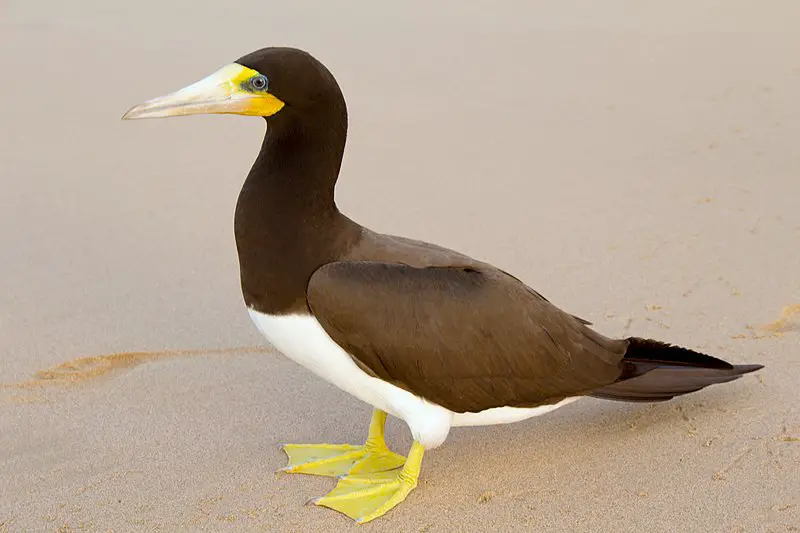
The Brown Booby is a large, seabird from the booby family Sulidae. It has a pantropical range and can be found in many areas of the world.
This bird lives in flocks and forages by plunging into shallow waters to catch small fish that are driven near the surface by predators or storms.
The brown booby is known for its short wings which make it highly maneuverable when hunting; this allows it to pursue prey quickly with sudden turns and dives.
Its diet also includes squid, crustaceans, eggs of other birds, as well as scraps from boats or ships they may come across while flying around coastlines.
They sometimes rest on floating objects during their long flights over open water between islands or continents.
Scientific classification:
| Kingdom | Animalia |
| Phylum | Chordata |
| Class | Aves |
| Order | Suliformes |
| Family | Sulidae |
| Genus | Sula |
| Species | S. leucogaster |
13. Bulwer’s Petrel
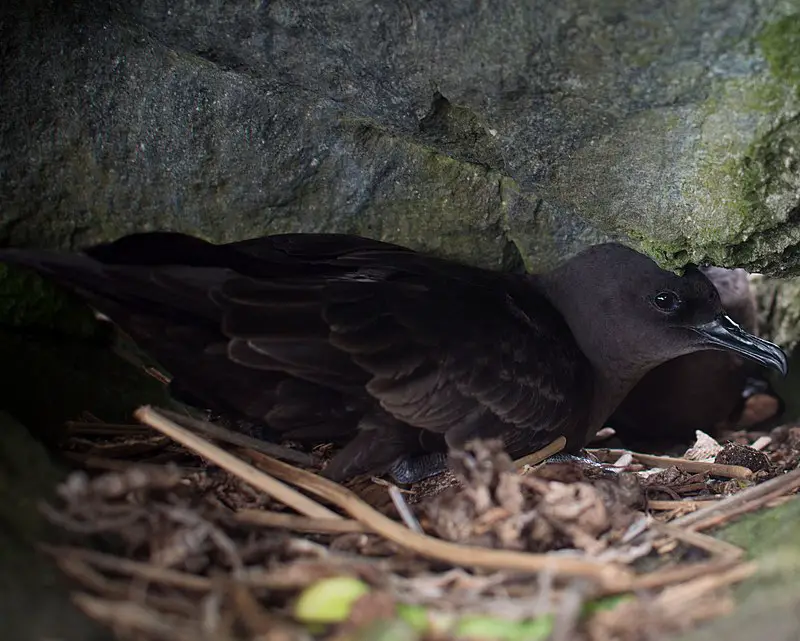
Bulwer’s petrel is a small seabird in the Procellariidae family which can be found across tropical and subtropical regions of the Atlantic, Indian and Pacific Oceans.
It was named after English naturalist James Bulwer who first described it in 1828 along with Jardine and Selby.
The bird has dark greyish plumage on its back while the underside is typically white or pale grey.
Its wings are short but broad making them ideal for soaring high above large bodies of water looking for food such as squid, fish, crustaceans and insects.
They use their long pointed bill to catch prey from both surface-skimming dives or underwater plunges up to 15 meters deep.
These birds nest burrows dug into soil cliffs where they lay just one egg each year which takes about 55 days to hatch.
Scientific classification:
| Kingdom | Animalia |
| Phylum | Chordata |
| Class | Aves |
| Order | Procellariiformes |
| Family | Procellariidae |
| Genus | Bulweria |
| Species | B. bulwerii |
Also Featured In: Birds that Live in the Ocean , Hong Kong Birds You Need to See
14. Shrike
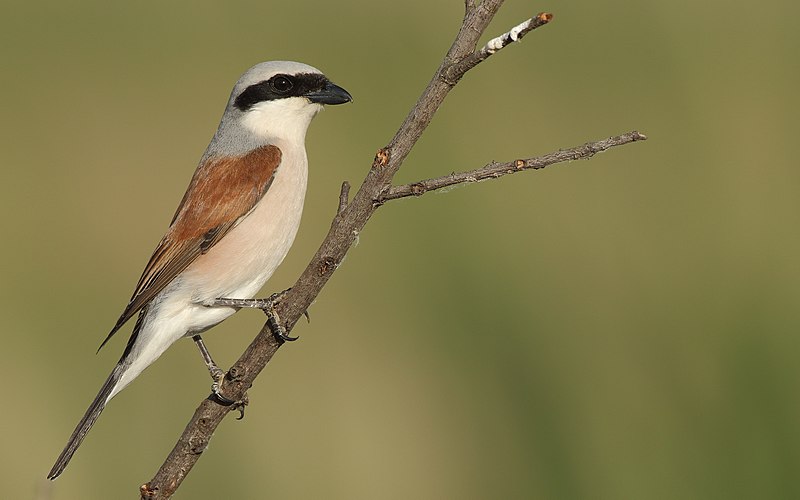
Shrikes are small passerine birds of the family Laniidae, with 34 species in four genera. They get their name from Old English word “scrīc”, which refers to their shriek-like call.
These birds have earned the nickname ‘butcherbirds’ due to their feeding habits; they impale prey on thorns or barbed wire fences for later consumption.
Shrikes also tend to be aggressive predators and hunt a wide range of animals such as insects, small reptiles, rodents and even other smaller bird species.
In terms of physical appearance, these songbirds can vary greatly depending on the specific genus but usually boast a large hooked bill atop an impressive crest along with bright colors like gray, black or brownish hues across its feathers.
It’s clear shrike is quite remarkable creature that has gained notoriety for both hunting prowess and distinctive vocalizations.
Scientific classification:
| Kingdom | Animalia |
| Phylum | Chordata |
| Class | Aves |
| Order | Passeriformes |
| Superfamily | Corvoidea |
| Family | Laniidae Rafinesque, 1815 |
15. Hoopoes
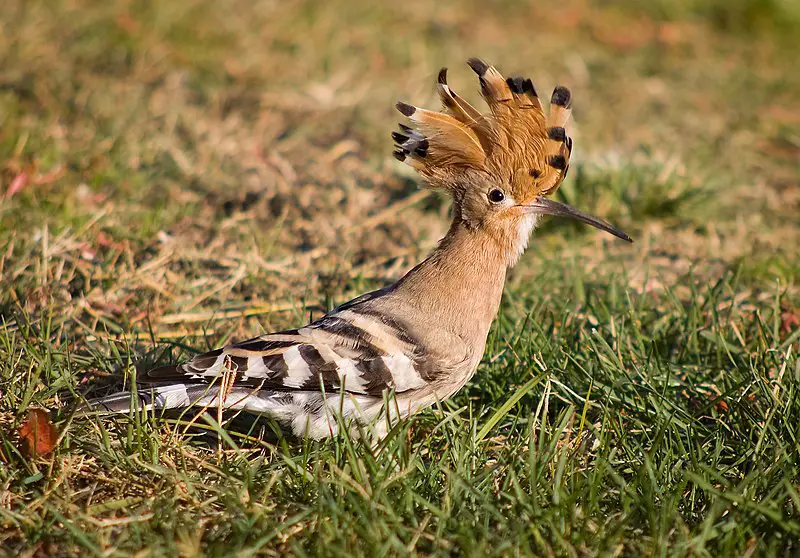
Hoopoes are a fascinating species of bird, found across Africa, Asia and Europe. They have beautiful plumage with unique ‘crowns’ of feathers on their heads.
Three living and one extinct species exist – although for some time they were all classed as the same species: Upupa epops. Some taxonomists still believe this to be true.
These birds are often associated with royalty due to the impressive crown-like crest atop their head, adding an extra element of mystery and exoticism to these creatures.
Hoopoes can also produce loud calls which sound like “hoo-poo” hence why they’ve been given such an apt name.
Scientific classification:
| Kingdom | Animalia |
| Phylum | Chordata |
| Class | Aves |
| Order | Bucerotiformes |
| Family | Upupidae Leach, 1820 |
| Genus | Upupa Linnaeus, 1758 |
16. Brown-Necked Raven
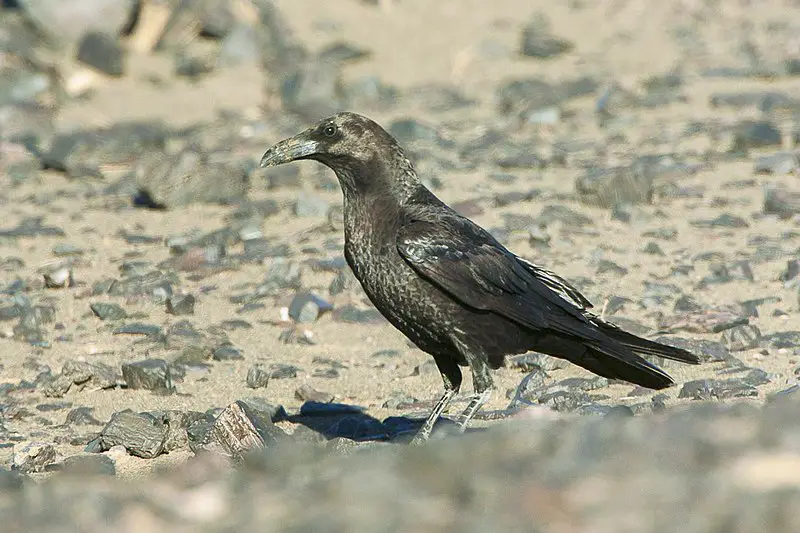
The Brown-necked Raven is a sturdy, large bird. It has an average length of 52 – 56 cm and similar proportions to the Common Raven but with a smaller bill.
Its distinct brownish black head and throat give it its name; the rest of its plumage consists of grey on the back, wings and tail feathers, as well as white underparts.
This species can be found in parts of North Africa, Asia Minor and across most areas in Iran.
They have also been known to inhabit forest edges or other open woodlands where they feed mainly on small mammals such as rodents, lizards, insects or even carrion when necessary for survival.
The Brown-necked raven is highly intelligent birds that form strong family bonds which last until death do them part.
Scientific classification:
| Kingdom | Animalia |
| Phylum | Chordata |
| Class | Aves |
| Order | Passeriformes |
| Family | Corvidae |
| Genus | Corvus |
| Species | C. ruficollis |
17. Sylviid Warblers
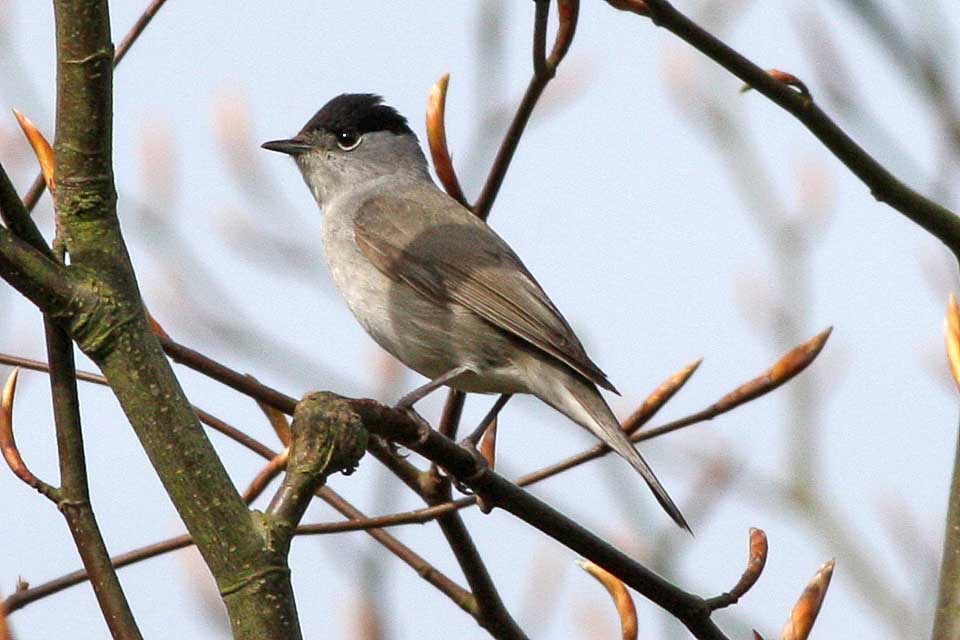
The Sylviid warblers are a family of passerine birds found in Eurasia and Africa. They include the typical warblers as well as babblers that were formerly part of the Old World babbler family.
These birds have slender bodies, pointed wings, long tails and strong legs adapted for ground-dwelling habits like running or hopping along branches.
The male often has bright colors while females are usually duller in coloration with more muted plumage patterns than males.
Some species also show sexual dimorphism where one sex may be larger or smaller than its counterpart; for instance some species may have longer tail feathers on the female side compared to their male counterparts.
Many members of this group feed on insects but some specialize on seeds, fruits, nectar or even frogs.
Scientific classification:
| Kingdom | Animalia |
| Phylum | Chordata |
| Class | Aves |
| Order | Passeriformes |
| Superfamily | Sylvioidea |
| Family | Sylviidae Leach, 1820 |
18. Skuas
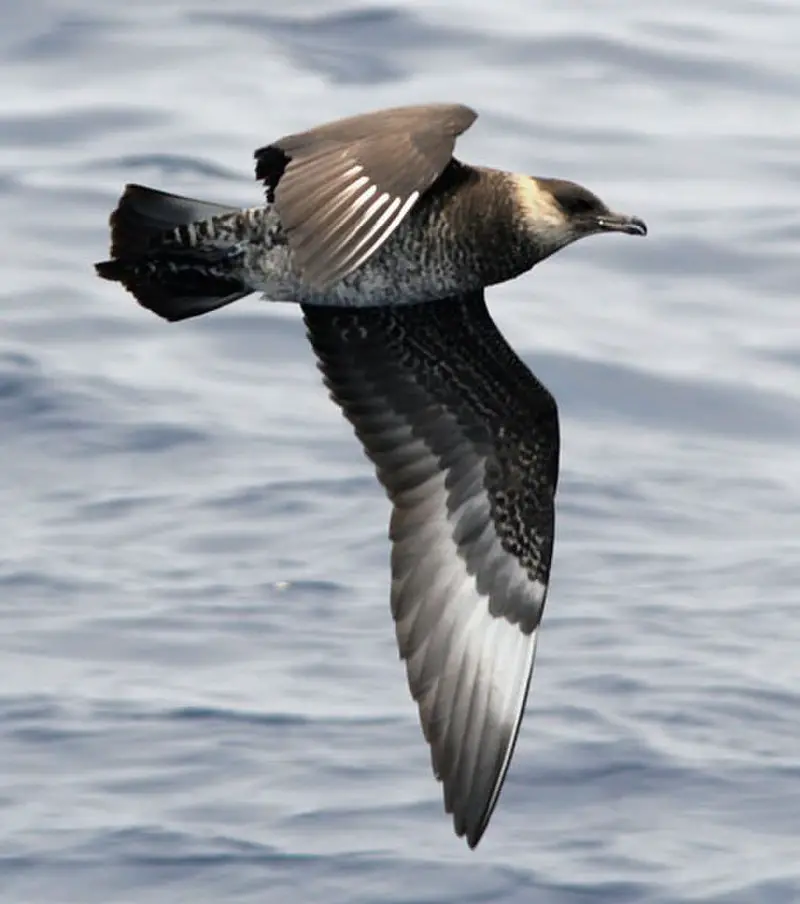
Skuas are a group of predatory seabirds with seven species, all belonging to the genus Stercorarius.
They are also known as “Jaegers” in North America and their name originates from the Faroese word for Great Skua – skúgvur.
These birds typically inhabit coastal areas or open oceans where they feed on fish, krill and other marine creatures.
Skuas can be distinguished by their pointed wings which help them fly long distances while hunting food.
Their distinctive colouration varies depending on age and habitat but generally includes greyish brown upperparts and white underparts with black streaks along its belly area.
The overall size ranges from 24-40 cm making these one of the larger sea bird species.
Scientific classification:
| Kingdom | Animalia |
| Phylum | Chordata |
| Class | Aves |
| Order | Charadriiformes |
| Suborder | Lari |
| Family | Stercorariidae Gray, 1871 |
| Genus | Stercorarius Brisson, 1760 |
19. Phasianidae
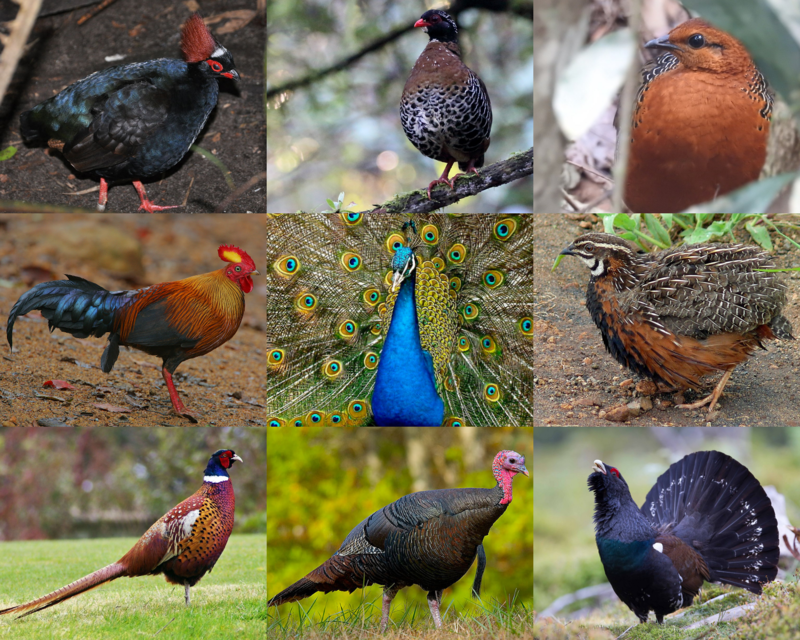
The Phasianidae family of birds is one that contains many popular gamebirds, with a total of 185 species divided across 54 genera.
These heavy ground-living birds include pheasants, partridges, junglefowl, chickens, and turkeys among others like Old World quail and peafowl.
This large family was formerly split into two subfamilies known as the Phasianinae and Perdicinae but this classification has since been changed to reflect more current scientific findings on them.
All these different types of birds have certain things in common such as their strong legs for scratching through leaves or soil looking for food items including insects, seeds, and other vegetation which makes up most of their diet.
They also all tend to be quite colorful in order to attract mates during breeding season when males will often display vibrant feathers or do dances around females in an attempt at courtship ritual displays.
The majority are monogamous creatures too although some may form short-term pair bonds before going off alone again once mating has taken place – either way.
There tends to be very little parental care given by adults after eggs have hatched so chicks need to fend for themselves right away.
Scientific classification:
| Kingdom | Animalia |
| Phylum | Chordata |
| Class | Aves |
| Order | Galliformes |
| Superfamily | Phasianoidea |
| Family | Phasianidae Horsfield, 1821 |
20. Plovers

Plovers are a family of around 64-68 species of ground-dwelling birds, commonly found in open country such as fields, meadows and tundras.
They have short bills with webbed feet to help them forage through mud or shallow water.
Plover plumage is usually mottled brown though some species may have brighter colors on the head and wings.
These birds feed mainly on insects but can also eat small crustaceans and worms.
Plovers breed during springtime when they dig holes in sandy or pebbled beaches to lay their eggs which hatch after about 3 weeks incubation period.
They use distraction display behaviour by pretending an injury to the predators away from their nests if needed for protecting their young ones.
Scientific classification:
| Kingdom | Animalia |
| Phylum | Chordata |
| Class | Aves |
| Order | Charadriiformes |
| Family | Charadriidae Leach, 1820 |
21. Glareolidae
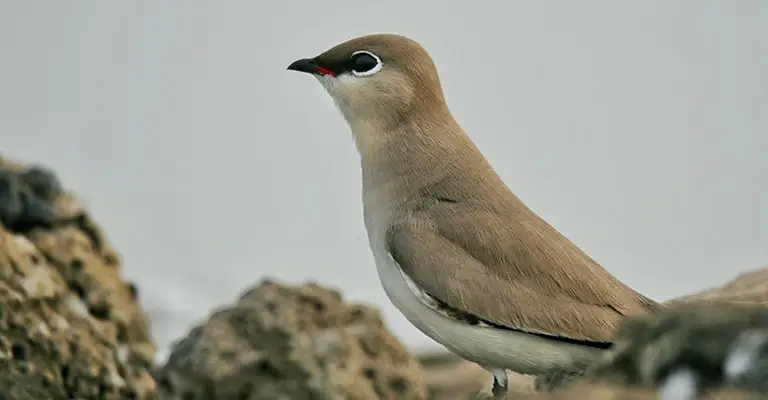
Glareolidae is a family of wading birds, consisting of four genera and 17 species. They are distinguished from other charadrii by their long bills which have a slight downward curve.
Glareolidae live around open grasslands and deserts, where they hunt for insects using the bill to probe into soil or vegetation.
Most species are found in Africa but two pratincoles inhabit parts of Europe and Asia as well.
Coursers tend to be larger than pratincoles with longer legs allowing them to run quickly across sandy dunes while feeding on small animals like lizards or spiders.
Pratincoles feed mainly on flying insects, snatching them out of midair with great agility during flight.
All glareolids share unique features such as large eyes that help it spot prey at night easily making this group one interesting bird family.
Scientific classification:
| Kingdom | Animalia |
| Phylum | Chordata |
| Class | Aves |
| Order | Charadriiformes |
| Suborder | Lari |
| Family | Glareolidae CL Brehm, 1831 |
22. Austral Storm Petrels
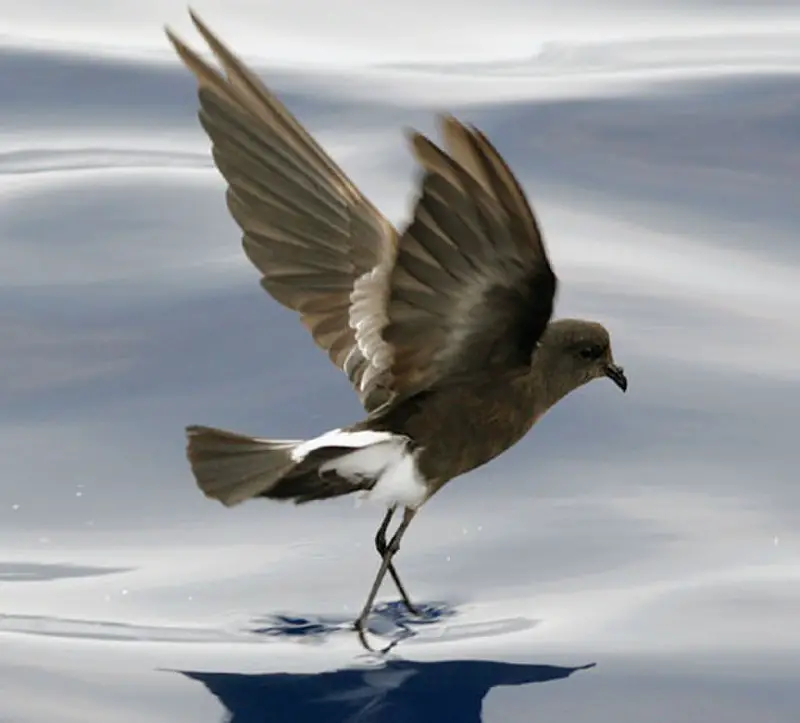
Austral Storm Petrels are the smallest of seabirds, belonging to the family Oceanitidae and order Procellariiformes.
They have a cosmopolitan distribution across all oceans, with their flight being fluttering and sometimes bat-like in appearance.
These birds feed on planktonic crustaceans as well as small fish that they pick from the surface while hovering over it.
Their plumage is mostly dark grey or blackish brown above; underparts may be white or mottled gray.
The feet vary between species but usually have pale yellow webs and claws which help them move easily through water when searching for food.
Austral storm petrels often make nests on remote islands where these birds can breed safely without any disturbances from humans during their nesting season.
Scientific classification:
| Kingdom | Animalia |
| Phylum | Chordata |
| Class | Aves |
| Order | Procellariiformes |
| Family | Oceanitidae Forbes, 1881 |
23. Falcons And Caracaras
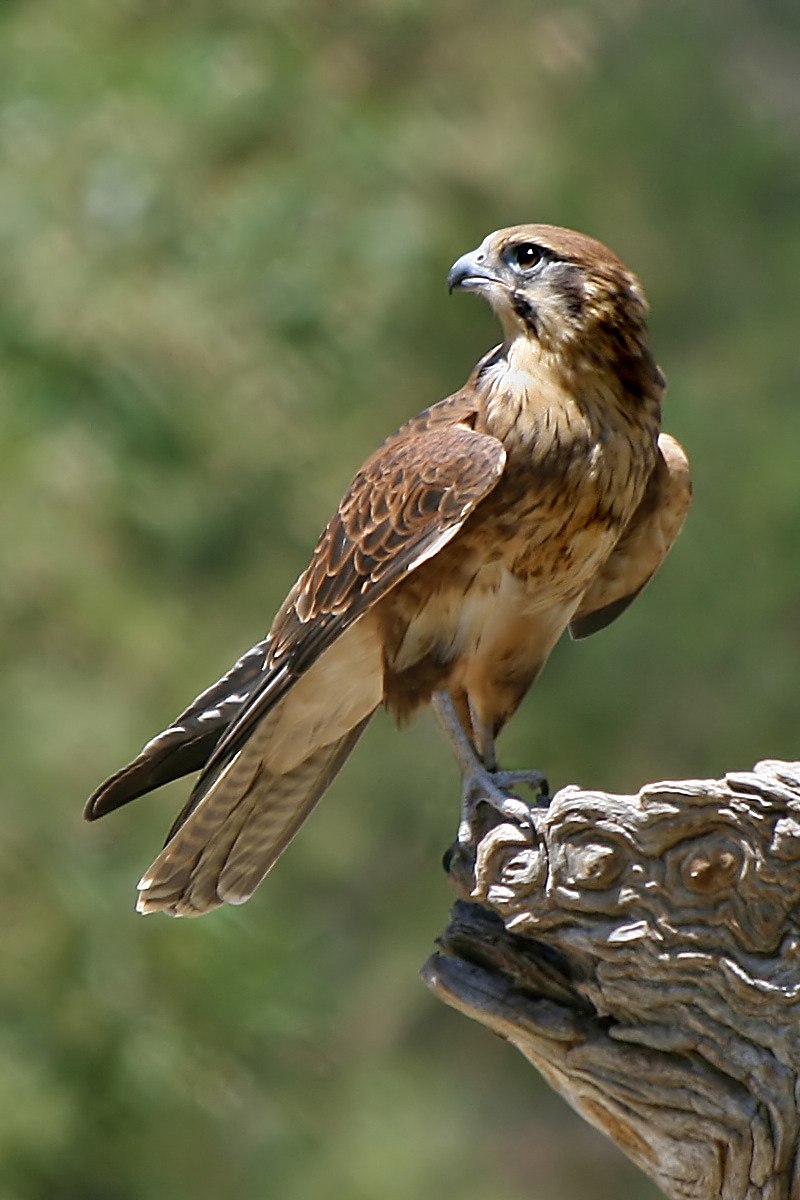
Falcons and caracaras are birds of prey that belong to the family Falconidae. They have impressive sharp talons, hooked beaks and keen eyesight which makes them excellent hunters.
Falcons can reach speeds up to 200 mph when diving for their prey while caracaras use a combination of running and flying to hunt small mammals such as rabbits or rats.
Both falcons and caracaras live in various areas around the world from grasslands, deserts, forests, wetlands or even urban areas where they nest on cliffs or tall buildings.
The diet mainly consists insects but also includes larger animals like reptiles or other birds which they catch by surprise with fast dives out of the sky.
Scientific classification:
| Kingdom | Animalia |
| Phylum | Chordata |
| Class | Aves |
| Order | Falconiformes |
| Family | Falconidae Leach, 1820 |
24. Eurasian Reed Warbler
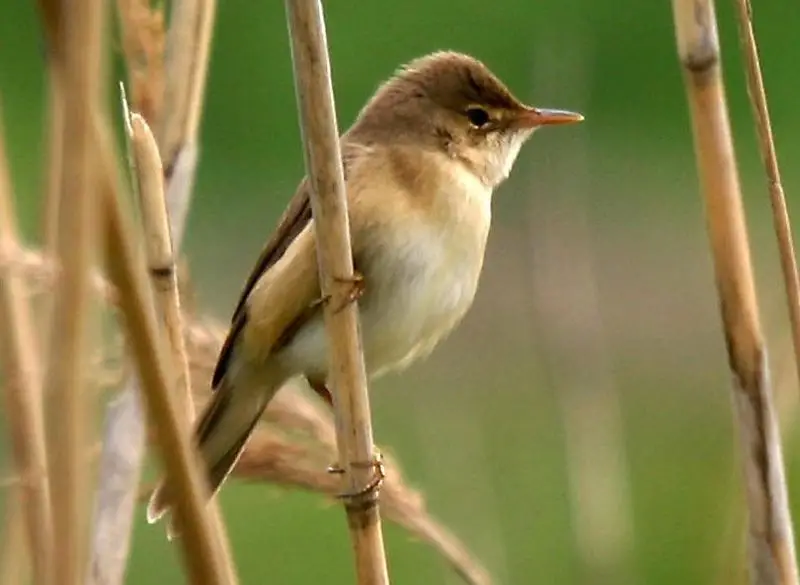
The Eurasian reed warbler (Acrocephalus scirpaceus) is a species of Old World Warbler native to the temperate parts of Europe and Asia.
It breeds in wetlands such as marshes, ponds and rivers with dense vegetation like reeds or tall grasses.
During its wintering season, it migrates southward to sub-Saharan Africa where there are milder conditions.
This small bird has streaked brown plumage on the upperparts and white underparts which makes it difficult for predators to spot among the foliage.
Its diet consists mainly of insects including aphids, caterpillars larvae and moths caught while flying over water or by gleaning from plants growing near water bodies.
The male sings an attractive song consisting of several phrases repeated one after another as part of their courtship display during breeding season in order attract females for mating purposes.
Scientific classification:
| Kingdom | Animalia |
| Phylum | Chordata |
| Class | Aves |
| Order | Passeriformes |
| Family | Acrocephalidae |
| Genus | Acrocephalus |
| Species | A. scirpaceus |
25. Threskiornithidae
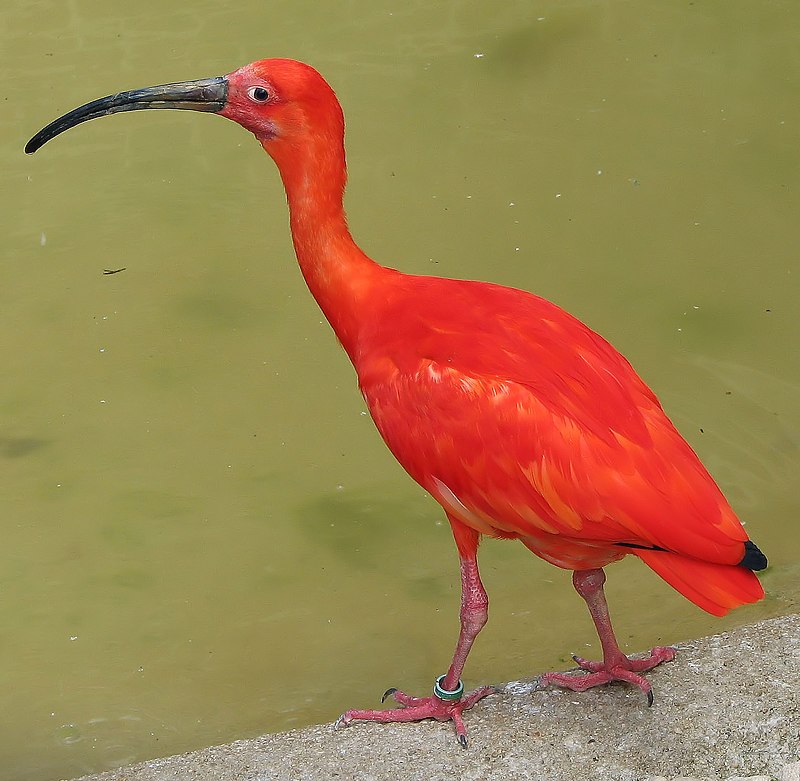
Threskiornithidae is a family of large wading birds which includes 36 species. These birds are traditionally divided into two subfamilies – the ibises and the spoonbills.
However, recent genetic analysis has shown that spoonbills actually belong to Old World ibis group, while New World ibises form an early offshoot from this lineage.
Threskiornithidse members have long curved beaks with serrated edges used for catching fish in shallow water or mudflats, as well as other aquatic invertebrates like crustaceans and mollusks.
They also feed on plant matter such as grains and seeds found close to wetlands areas where they live.
This diverse diet makes them important scavengers in their ecosystems, helping maintain healthy populations of native wildlife by controlling insect numbers and dispersing energy-rich seeds throughout wetland habitats.
Scientific classification:
| Kingdom | Animalia |
| Phylum | Chordata |
| Class | Aves |
| Order | Pelecaniformes |
| Suborder | Ardei |
| Family | Threskiornithidae Richmond, 1917 |
26. Grey-Headed Kingfisher
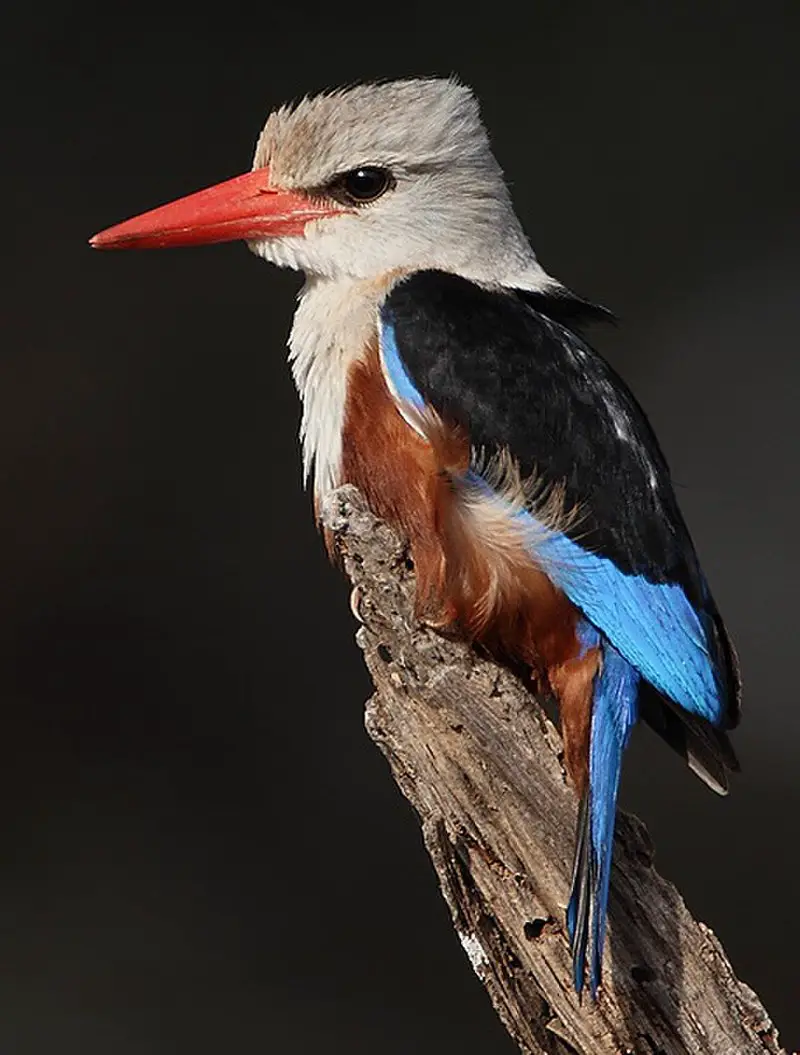
The Grey-headed Kingfisher is a stunning species of kingfisher that can be found across much of Africa and the Middle East. Its striking grey head, white neck, black back and wings with blue speckles make it an instantly recognizable bird.
It has been described formally by German zoologist Philipp Ludwig Statius Müller since 17.
This small but beautiful predator feeds mainly on insects such as beetles, grasshoppers and cicadas which they catch while hovering over water or in flight from perches up to 20 meters above ground level.
They are monogamous birds who will form lifelong pair bonds during mating season when males display courtship behavior including tail fanning and bill clacking displays at their chosen mate’s nest site.
These little birds play an important part in African ecosystems so we should all take care to preserve them for future generations.
Scientific classification:
| Kingdom | Animalia |
| Phylum | Chordata |
| Class | Aves |
| Order | Coraciiformes |
| Family | Alcedinidae |
| Subfamily | Halcyoninae |
| Genus | Halcyon |
| Species | H. leucocephala |
27. Cream-Colored Courser
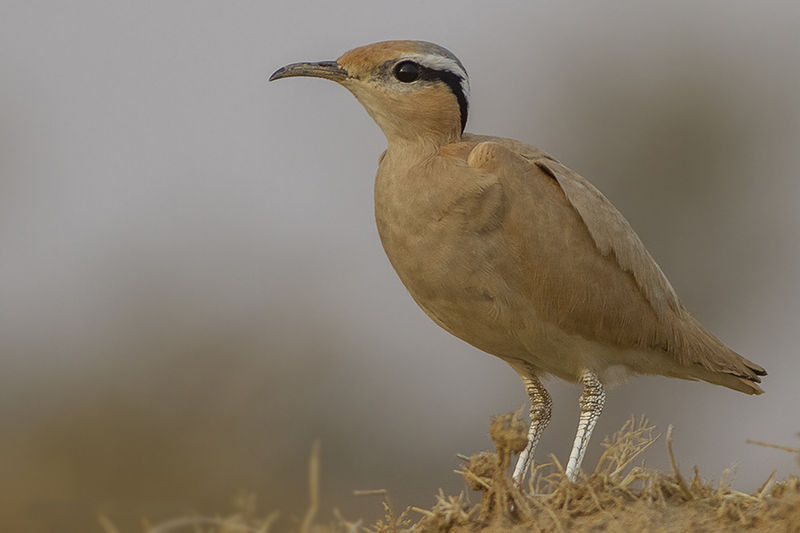
The Cream-colored Courser is a species of wader belonging to the Glareolidae family. It can be found across Western Asia and North Africa and inhabits dry, open semi-desert habitats.
These birds have adapted well to their environment; they are able to run quickly in search of insect prey on the ground which explains their scientific name Cursorius cursor – derived from Latin for ‘runner’.
The coursers also inhabit the Canary Islands as well as Cape Verde where breeding occurs during summer months before migration back south begins in autumn and winter months.
They are easily identified by their distinctive cream coloration with brown streaking along wings, neck and chest region making them an important part of these arid ecosystems.
Scientific classification:
| Kingdom | Animalia |
| Phylum | Chordata |
| Class | Aves |
| Order | Charadriiformes |
| Family | Glareolidae |
| Genus | Cursorius |
| Species | C. cursor |
28. Motacillidae
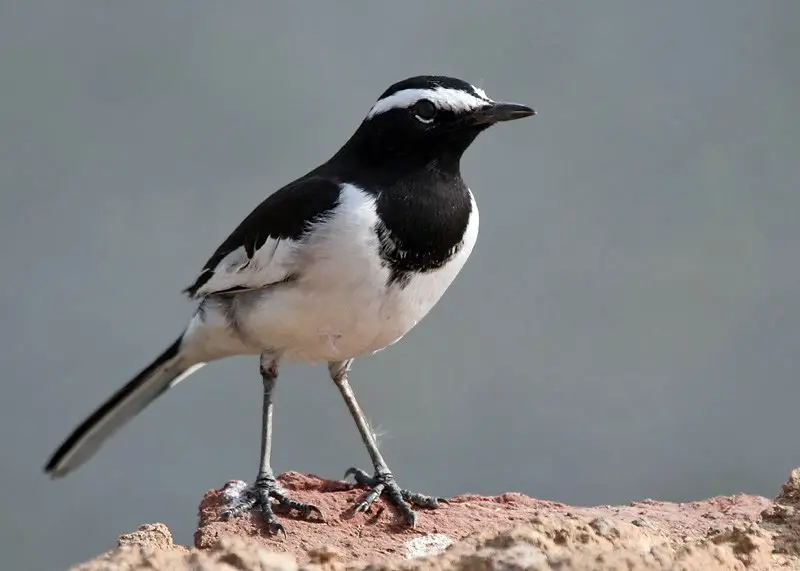
Motacillidae is a family of small passerine birds consisting of around 70 species. They are found across Europe, Africa, Asia and even Alaska with two migratory breeding species.
The three genera they belong to include wagtails which typically have medium to long tails; longclaws that can only be spotted in the Afrotropics; and pipits which possess the most cosmopolitan distribution worldwide.
These birds feed on insects as well as seeds for their diets and are usually seen in open habitats such grasslands or wetlands where food sources like invertebrates can easily be accessed.
Most Motacillidae species also use mud nests during breeding season making them easy targets for predators so it’s important we protect these beautiful creatures.
Scientific classification:
| Kingdom | Animalia |
| Phylum | Chordata |
| Class | Aves |
| Order | Passeriformes |
| Superfamily | Passeroidea |
| Family | Motacillidae Horsfield, 1821 |
29. Rollers

Rollers are birds that belong to the Coraciidae family. They are known for their aerial acrobatics which they display during courtship or territorial flights, earning them their name.
Rollers share similarities with crows in terms of size and shape, but they have a more vibrant appearance like kingfishers and bee-eaters — blues and pinkish or cinnamon browns being the most common colors.
These birds also have an interesting feature: two inner front toes connected together while the outer ones remain separated from each other.
Their impressive flying skills make rollers one of nature’s beauties, captivating us all with its colorful feathers and graceful moves.
Scientific classification:
| Kingdom | Animalia |
| Phylum | Chordata |
| Class | Aves |
| Order | Coraciiformes |
| Family | Coraciidae Rafinesque, 1815 |
30. Old World Flycatchers
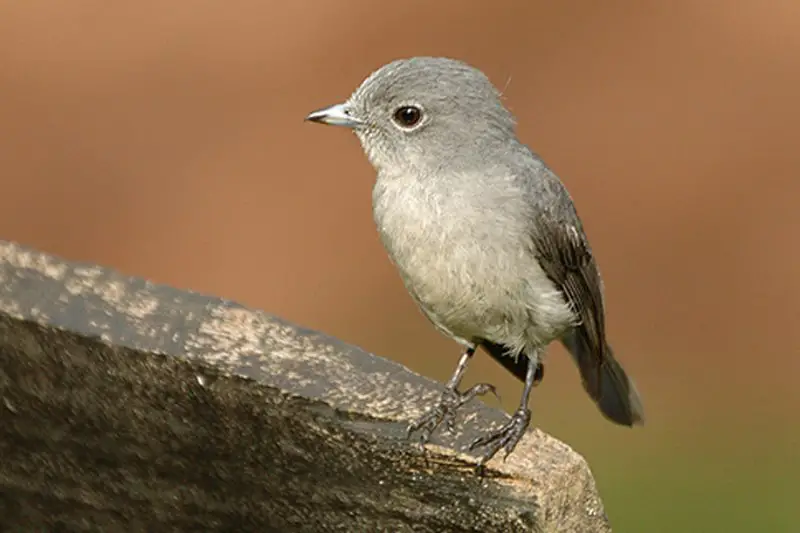
The Old World Flycatcher is a family of small passerine birds, native to Europe, Africa and Asia. They are mainly insectivorous arboreal birds that feed on insects they catch in the air or trees.
Their wingspan ranges from 5-11 inches long with males usually being slightly larger than females.
The coloration of these birds can range greatly depending on species but typically have dull greyish brown upperparts and pale undersides which help them blend into their environment for hunting purposes.
Bluethroat (Luscinia svecica) and Northern Wheatear (Oenanthe oenanthe) are two exceptions as they can be found in North America too.
These charming little creatures make fun additions to birdwatching lists all over the world because of their vibrant colors and interesting behaviors.
Scientific classification:
| Kingdom | Animalia |
| Phylum | Chordata |
| Class | Aves |
| Order | Passeriformes |
| Superfamily | Muscicapoidea |
| Family | Muscicapidae Fleming J., 1822 |
31. Old World Orioles
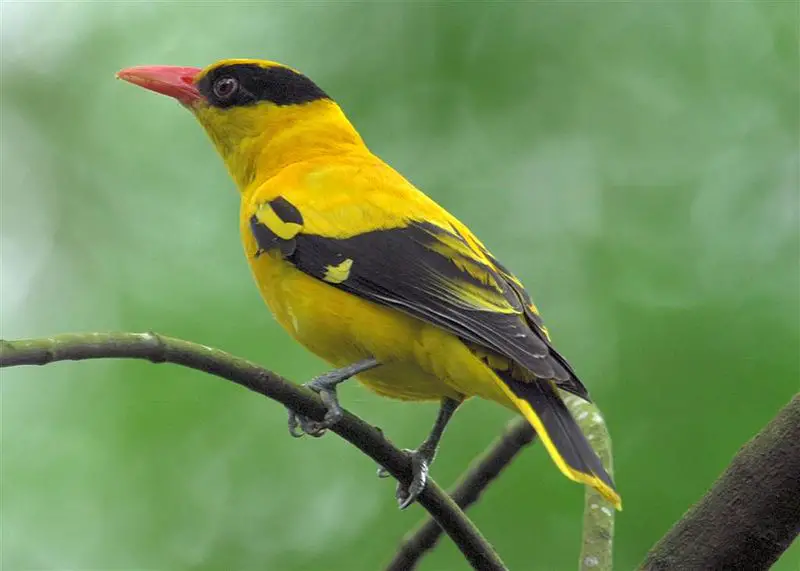
Old World orioles are a family of passerine birds found in the Old World. It comprises four genera: piopios, figbirds, pitohuis and the original genus Oriolus.
The African black-headed species have sometimes been removed from this latter group due to their distinct characteristics as well as other proposed splits for Oriolus.
These colorful birds can be identified by their bright yellow or orange plumage that often features darker markings on wings and head areas, although some species may also display a blue hue or stripes across the body feathers.
They typically feed on insects such as caterpillars and grasshoppers but will supplement with small fruits when available too – making them beneficial additions to gardens.
Scientific classification:
| Kingdom | Animalia |
| Phylum | Chordata |
| Class | Aves |
| Order | Passeriformes |
| Superfamily | Orioloidea |
| Family | Oriolidae Vigors, 1825 |
32. Bee-Eater
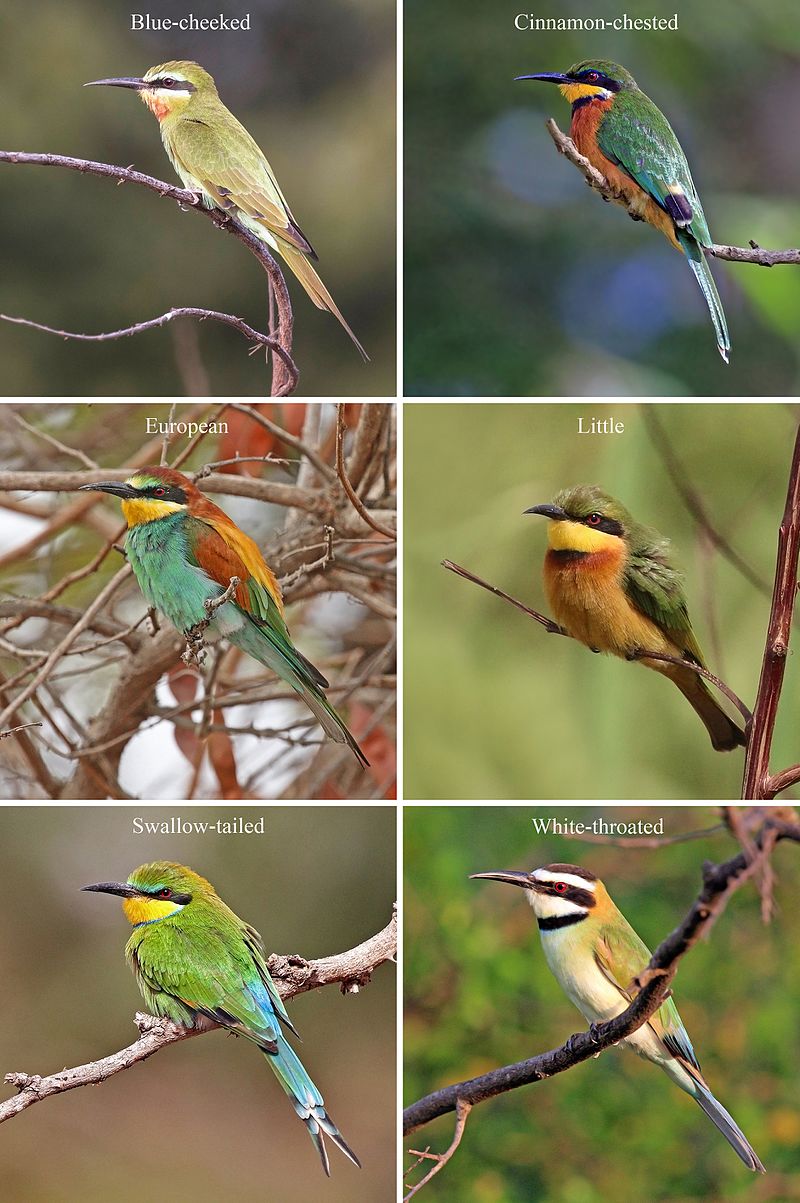
Bee-eaters are one of the most beautiful and vibrant birds in existence. They have a slender body, long wings, down turned bills and their signature elongated central tail feathers which make them instantly recognizable from afar.
Their plumage is incredibly colorful with many shades ranging from blues to greens to reds that glisten when they fly through the air.
These stunning creatures can be found all over Africa, Asia, Southern Europe, Australia and New Guinea where they feed mainly on bees but also other insects like flies or wasps as well as small mammals such as lizards or rodents.
Bee-eaters live in colonies near rivers or wetlands so that they may easily hunt for food while staying close together for safety purposes.
Additionally it allows them to better display their impressive courtship dances during mating season.
Scientific classification:
| Kingdom | Animalia |
| Phylum | Chordata |
| Class | Aves |
| Order | Coraciiformes |
| Family | Meropidae Rafinesque, 1815 |
33. Psittaculidae
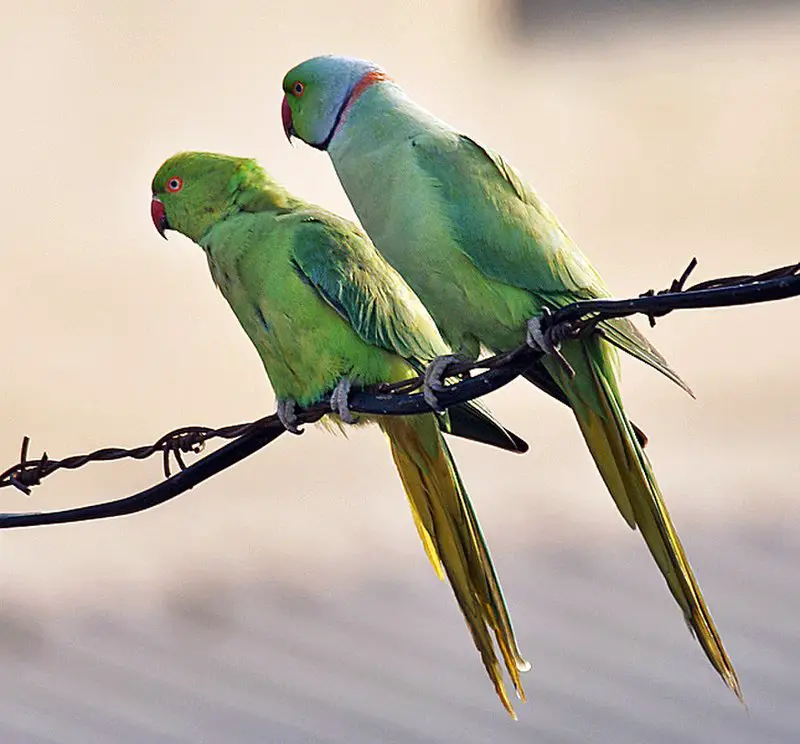
Psittaculidae is a family of Old World parrots that consists of five subfamilies. It includes 192 species divided into 53 genera, and has been accepted by the Clements Checklist of Birds as well as IOC World Bird List.
These birds are known for their bright colours, strong beaks and powerful vocalisations. They can also mimic human sounds including words when taught properly with patience and consistency.
They live in warm climate regions such as Africa, Asia Pacific Islands, Australia and Oceania where they enjoy plentiful food sources like fruits, nuts and seeds in abundance.
Psittaculids are typically found living in groups or pairs instead of alone because they enjoy socialising with others from within their own kind.
Scientific classification:
| Kingdom | Animalia |
| Phylum | Chordata |
| Class | Aves |
| Order | Psittaciformes |
| Superfamily | Psittacoidea |
| Family | Psittaculidae Vigors, 1825 |
34. Greater Hoopoe-Lark
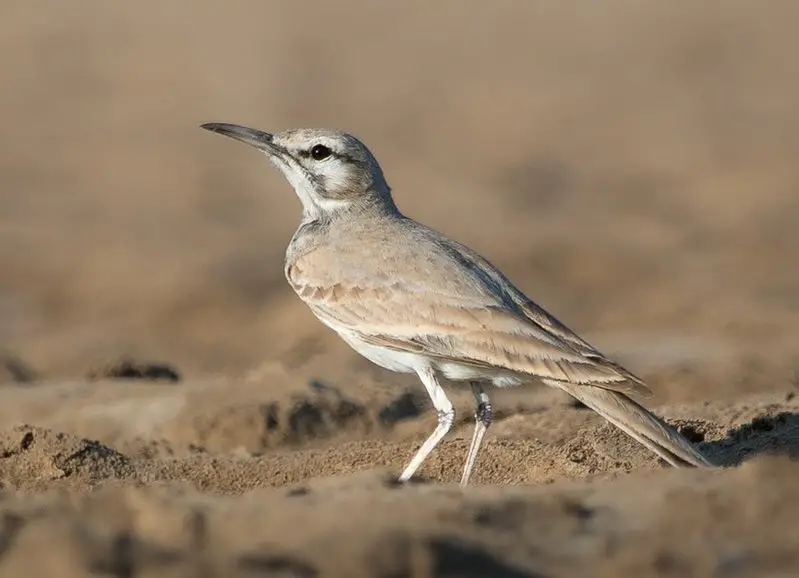
The Greater hoopoe-lark is a passerine bird that can be found in arid and semi-desert regions of Africa, the Arabian peninsula, Syria, Afghanistan, Pakistan and India.
It was formerly known as the bifasciated lark or large desert lark. These birds have adapted to living in harsh climates with little water sources by having sparse feathers which helps them retain body heat during cold nights.
They are also able to consume insects from dry soils for sustenance when food resources become scarce.
During mating season they display their distinctive markings by singing from atop bushes or trees while flapping their wings vigorously before swooping down towards potential mates on the ground below.
The greater hoopoe-larks diet mainly consists of seeds and small invertebrates like beetles, spiders and larvae making them an important part of maintaining local insect populations too.
Scientific classification:
| Kingdom | Animalia |
| Phylum | Chordata |
| Class | Aves |
| Order | Passeriformes |
| Family | Alaudidae |
| Genus | Alaemon |
| Species | A. alaudipes |
35. Western Reef Heron
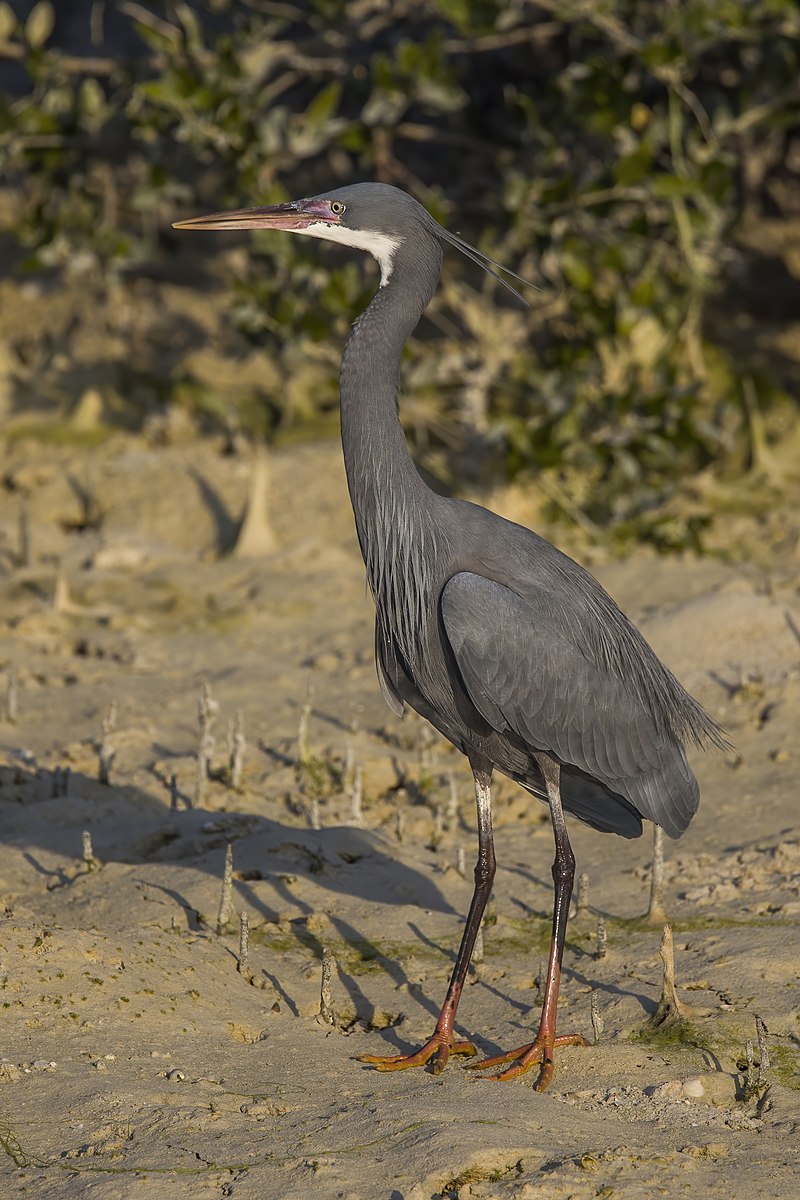
The western reef heron, also known as the western reef egret, is a medium-sized bird found in southern Europe, Africa and some parts of Asia. It usually inhabits coastal areas and has two distinctive plumage forms.
The slaty-grey form can be mistaken for the rare dark morph of the Little Egret while its white form looks similar to that of an immature Grey Heron.
This species feeds mainly on fish but will occasionally eat insects or other small aquatic animals like crabs and molluscs too.
Western Reef Herons are solitary birds that nest near water bodies where they build nests from sticks which may sometimes contain feathers or seaweed as well.
They have become endangered since their habitats have been destroyed due to human activities such as building developments along coastlines; however conservation efforts are being taken to ensure their survival into future generations.
Scientific classification:
| Kingdom | Animalia |
| Phylum | Chordata |
| Class | Aves |
| Order | Pelecaniformes |
| Family | Ardeidae |
| Genus | Egretta |
| Species | E. gularis |
36. Bar-Tailed Lark
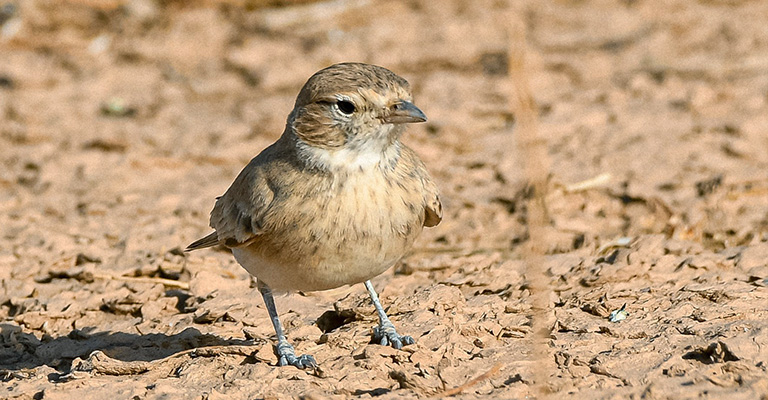
The Bar-tailed Lark is a species of lark belonging to the family Alaudidae. It is found in hot deserts from Morocco all the way to Pakistan, and can be quite common depending on its location.
Its plumage is mostly greyish brown with white patches on its wings and tail feathers. The underside has pale streaks, which vary depending upon subspecies.
They feed mainly on insects and seeds collected near ground level or sometimes plucked directly off plants while perching upright at their tips like other members of this family do when feeding.
During breeding season they form pairs that often defend small territories around their nest sites by singing loud territorial songs – making them easily recognisable birds in otherwise silent desert landscapes.
Scientific classification:
| Kingdom | Animalia |
| Phylum | Chordata |
| Class | Aves |
| Order | Passeriformes |
| Family | Alaudidae |
| Genus | Ammomanes |
| Species | A. cinctura |
37. White-Faced Storm Petrel
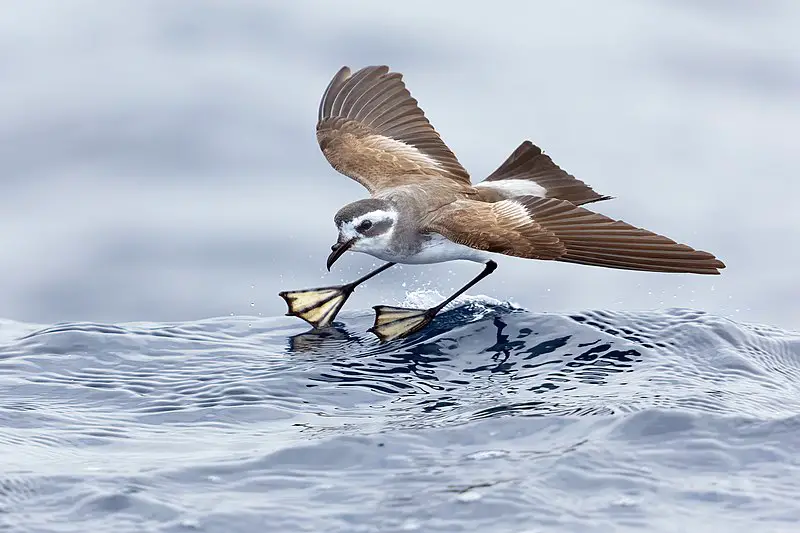
The White-faced Storm Petrel is a remarkable seabird belonging to the austral storm petrel family. It has a length of 19 to 21 centimetres and wingspan that ranges from 41 to 44 cm.
Its body is pale brown or grey, with blackish primaries in its wings and tail feathers.
The most distinctive feature is its white face which gives it an unmistakable appearance among other birds species.
These small, pelagic bird breed mainly on islands off New Zealand and Australia as well as Chile, Argentina, South Georgia and Tristan da Cunha Islands during summer season when they build their nests under rocks or burrows for laying eggs .
They feed by swimming underwater with their feet while searching for food like squid or fish near the surface of water.
In winter these birds migrate southwards where they spend time away from breeding grounds in order to survive cold weather conditions at higher latitudes.
Scientific classification:
| Kingdom | Animalia |
| Phylum | Chordata |
| Class | Aves |
| Order | Procellariiformes |
| Family | Oceanitidae |
| Genus | Pelagodroma Reichenbach, 1853[2] |
| Species | P. marina |
Also Featured In: Birds of Lanzarote, Most Common Birds in Stewart Island
38. Black-Crowned Sparrow-Lark
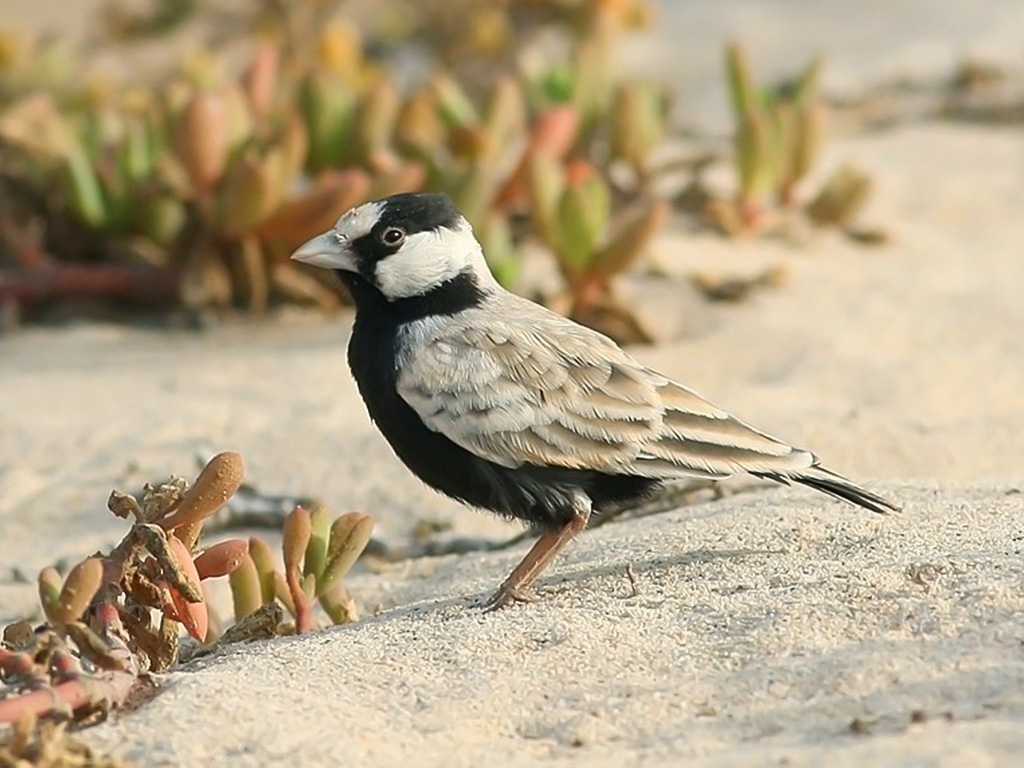
The black-crowned sparrow-lark is a species of lark found in northern Africa, the Middle East and north-western India. It resides in dry savanna habitats where it can be seen foraging for food on the ground.
The bird has an impressive white crest with distinctive black crown feathers that are only visible when viewed from above or behind.
Its brown upper parts mingle with its whitish underparts to provide excellent camouflage against predators, while its long legs allow it to run quickly across open fields if necessary.
Overall, this interesting little bird provides a fascinating sight as it hops around looking for food and flying through the air with grace and agility.
Scientific classification:
| Kingdom | Animalia |
| Phylum | Chordata |
| Class | Aves |
| Order | Passeriformes |
| Family | Alaudidae |
| Genus | Eremopterix |
| Species | E. nigriceps |
39. Amur Falcon

The Amur falcon is a beautiful bird of the falcon family, native to Siberia and parts of Northern China. Its plumage features dark sooty grey on its upperparts, with rufous thighs and vent.
In flight, it stands out with white wing linings contrasting against its dark wings feathers.
Each year it migrates in large flocks across India before flying over the Arabian Sea towards East Africa for wintering purposes.
It has been observed that these birds can fly up to 1000 miles per day during their long-distance migration.
This species have adapted well to human presence as they often use manmade structures such as transmission towers for roosting or nesting sites near villages like paddy fields where there’s an abundance of food sources like dragonflies and grasshoppers.
Scientific classification:
| Kingdom | Animalia |
| Phylum | Chordata |
| Class | Aves |
| Order | Falconiformes |
| Family | Falconidae |
| Genus | Falco |
| Species | F. amurensis |
Also Featured In: Urban Birds of Hong Kong,
40. Spanish Sparrow
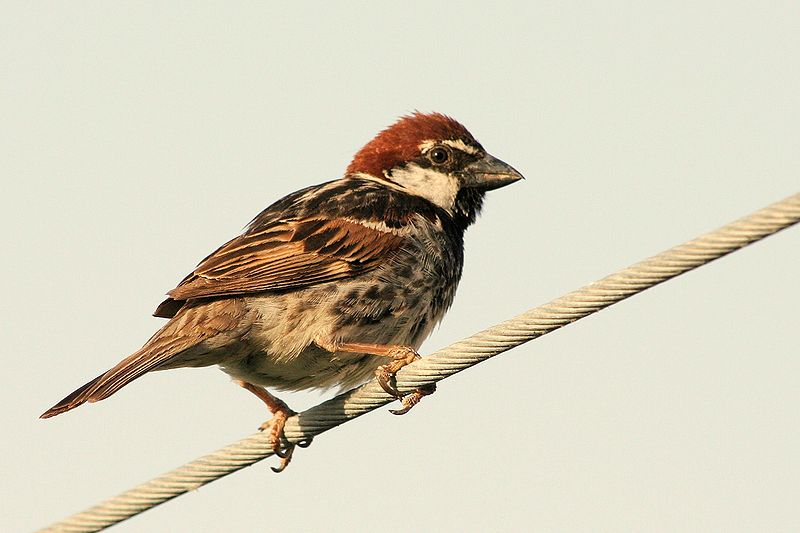
The Spanish sparrow or willow sparrow (Passer hispaniolensis) is a beautiful member of the passerine bird family Passeridae, found mainly in the Mediterranean region and south-west and central Asia.
With its striking colouration – having chestnut brown upperparts with black streaks on its back and wings, white underparts with greyish sidesand a distinctive black line running down either side of its head – it can easily be distinguished from other species.
It shares many physical characteristics with the closely related house sparrow but has some subtle differences such as being slightly smaller in size.
In addition to being an attractive species, they are also very sociable birds often nesting together in colonies making them easy to observe by birdwatchers alike.
Unfortunately hybridisation between these two species complicates their taxonomy which needs further research for clarification.
Scientific classification:
| Kingdom | Animalia |
| Phylum | Chordata |
| Class | Aves |
| Order | Passeriformes |
| Family | Passeridae |
| Genus | Passer |
| Species | P. hispaniolensis |
41. Black-Capped Petrel
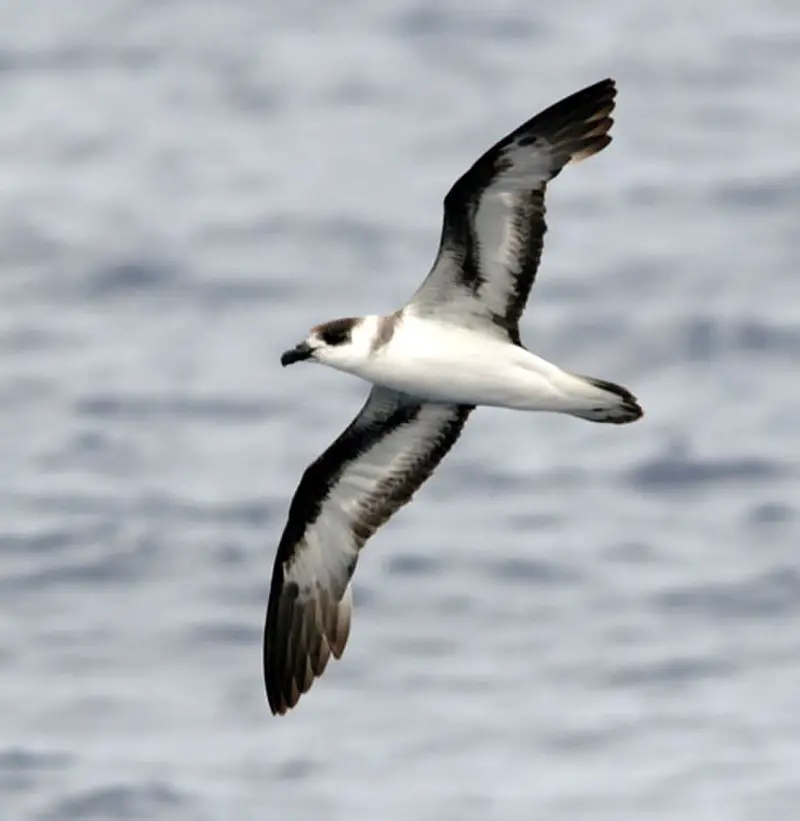
The Black-capped Petrel is a small seabird native to the West Indies. It has grey-brown back and wings, with a white nape and rump.
Its distinct feature is its black cap which extends to cover the eye in some individuals.
They have mainly white underparts apart from dark underwing markings as well.
These birds typically feed on crustaceans, fish eggs, squid or jellyfish plucked out of water while flying low over it with their relatively long wingspan aiding them in flight efficiency and speed.
Breeding season occurs around July-September during which they inhabit rocky cliff ledges near the shorelines for nesting purposes where they lay one egg at a time per nest.
Scientific classification:
| Kingdom | Animalia |
| Phylum | Chordata |
| Class | Aves |
| Order | Procellariiformes |
| Family | Procellariidae |
| Genus | Pterodroma |
| Species | P. hasitata |
42. Red-Footed Booby
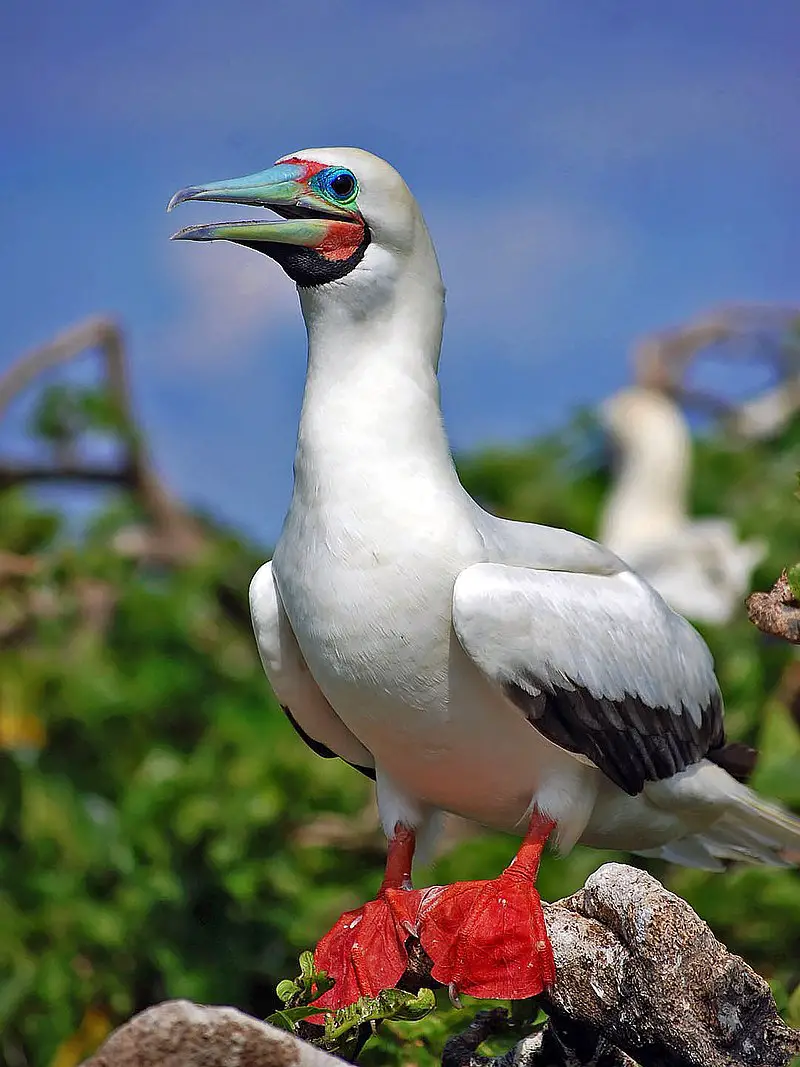
The Red-footed Booby is a large seabird of the Sulidae family, easily distinguished by its bright red feet. These birds are strong and agile fliers but can be clumsy in takeoffs and landings.
They live mostly in tropical areas and breed colonially on coastal islands all over the world.
The species faces few threats from either nature or humans, however their population has decreased slightly due to disturbances near breeding sites.
Despite this mild decline, they remain an incredibly common sight across many parts of the tropics – so much so that they have become symbolic with island life.
Scientific classification:
| Kingdom | Animalia |
| Phylum | Chordata |
| Class | Aves |
| Order | Suliformes |
| Family | Sulidae |
| Genus | Sula |
| Species | S. sula |
Also Featured In: Birds of Kauai, Hawaii, Galapagos Birds You Should Know
43. Great Shearwater
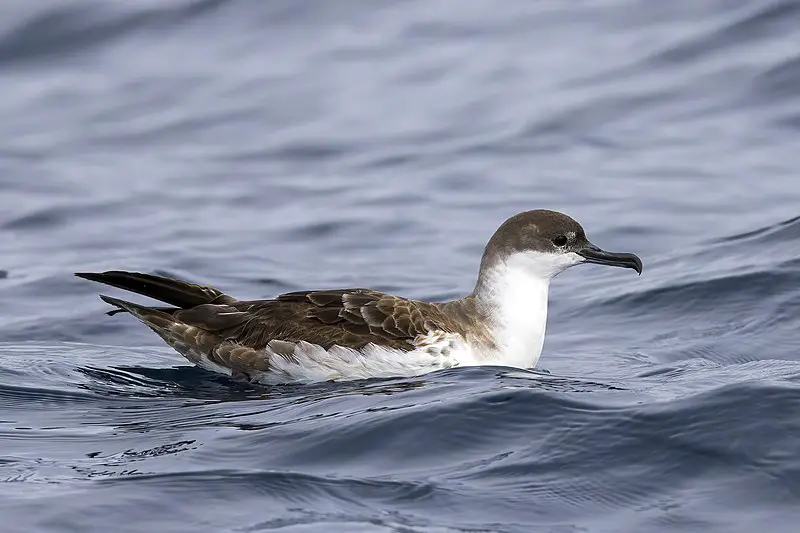
The Great Shearwater is a large seabird from the Procellariidae family. It breeds in colonies on rocky islands located in the South Atlantic, and during non-breeding season it can be found across most of the Atlantic Ocean.
It was first described by Irish naturalist Bernard O’Reilly in 1818 under its scientific name ‘Procellaria gravis’.
This bird has pale grey upper wings with a white underside that may sometimes show brownish markings around its neck area.
Its diet consists mainly of fish but also small squid, crustaceans and molluscs which they catch by surface plunging or pursuit diving while flying low over water surfaces.
The great shearwater is threatened to some extent due to human activities like fishing using gill nets, destruction of habitat for development projects as well as plastic debris ingested through feeding which affects their health adversely leading to mortality rates at an alarming rate making them vulnerable species.
Scientific classification:
| Kingdom | Animalia |
| Phylum | Chordata |
| Class | Aves |
| Order | Procellariiformes |
| Family | Procellariidae |
| Genus | Ardenna |
| Species | A. gravis |
Also Featured In: Birds that Live in Newfoundland and Labrador, Birds that Live in Faroe Islands
44. Spectacled Warbler
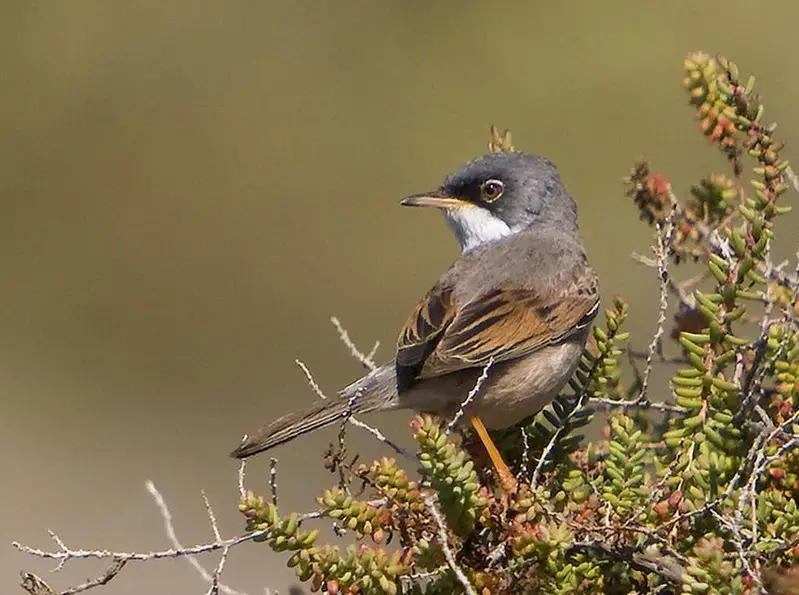
The Spectacled Warbler is a unique species of songbird found across northwest Africa, southwest Europe and the eastern Mediterranean.
It is named for its distinctive black spectacles around the eyes that give it an especially distinct appearance.
The bird has mainly brown-grey plumage with yellowish underparts, making them easy to identify in their natural habitats which include open woodlands and scrubby areas near rivers and coasts.
They typically feed on insects such as flies or caterpillars but will also consume fruit during times when food sources are scarce.
As they tend to be non-migratory birds they remain in their chosen habitat all year round providing much needed insect control services throughout different seasons.
Scientific classification:
| Kingdom | Animalia |
| Phylum | Chordata |
| Class | Aves |
| Order | Passeriformes |
| Family | Sylviidae |
| Genus | Curruca |
| Species | C. conspicillata |
Also Featured In: Most Common Birds of Sardinia, Fuerteventura Island Birds You Need to See
45. Atlantic Petrel
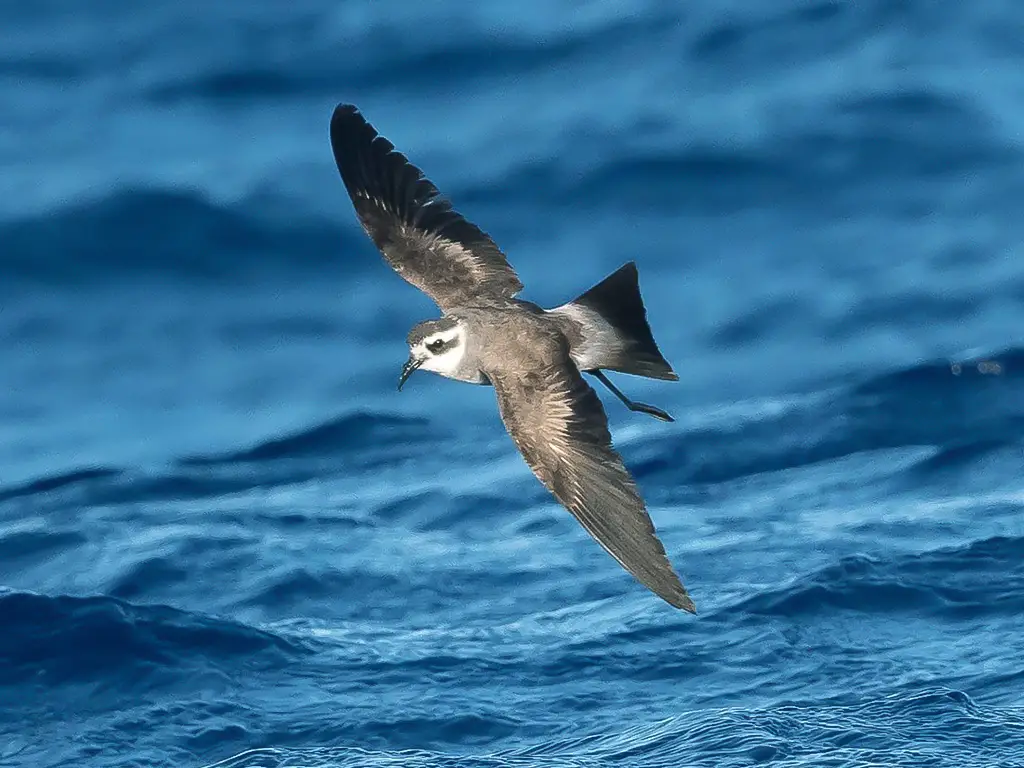
The Atlantic petrel is a large and stocky dark-colored seabird that can be found in the South Atlantic Ocean. It breeds in huge colonies on Tristan da Cunha and Gough Island, ranging from Brazil to Namibia at sea.
Most records of these birds exist to the west of their breeding islands along the subtropical convergence line.
Standing about 43 cm high, they are powerful flyers with white bellies and black wings tipped with white spots; underwings have an “M” pattern when viewed from above while flying overhead.
They prefer offshore waters over open ocean but will occasionally come to shore for rest or food during migration times as well as nesting season when it arrives.
Scientific classification:
| Kingdom | Animalia |
| Phylum | Chordata |
| Class | Aves |
| Order | Procellariiformes |
| Family | Procellariidae |
| Genus | Pterodroma |
| Species | P. incerta |
Also Featured In: Birds That Live In Tristan da Cunha, Gough Island Birds You Should Know
46. Ascension Frigatebird
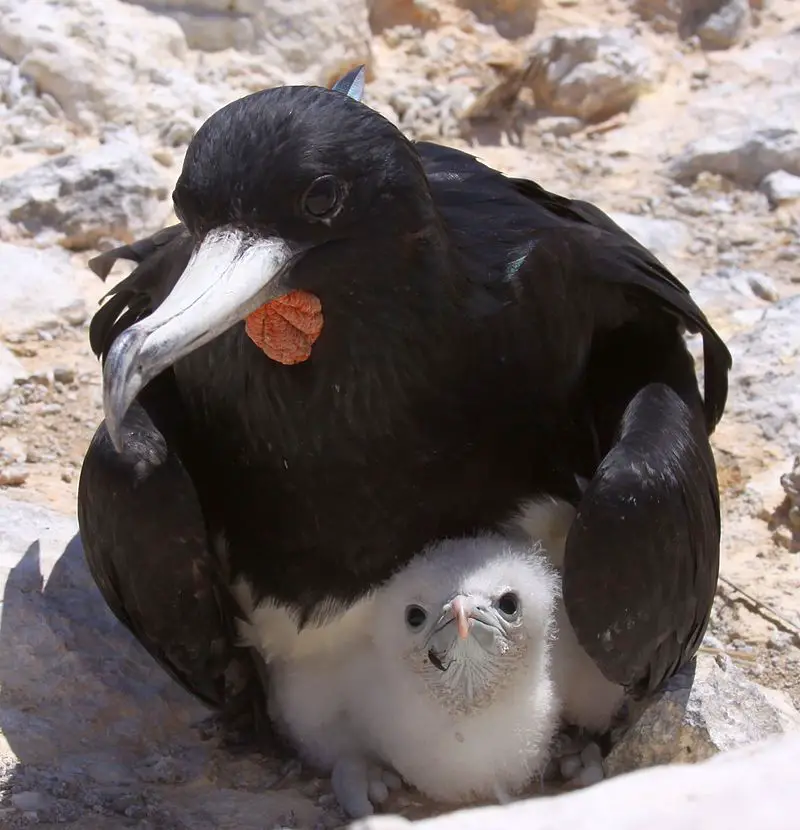
The Ascension frigatebird is a large, lightly built seabird with brownish-black plumage and deeply forked tail. It has a wingspan of around 2m (6.6ft), making it one of the largest sea birds in the world.
The male has an impressive red gular sac which he inflates to attract potential mates during breeding season.
Females are slightly smaller than males and lack the bright red throat pouch but have wide white stripes across their chest instead.
These amazing creatures can soar high above land or sea for hours at a time without flapping their wings.
They feed on fish, squid, crustaceans and other small marine life they catch while flying over water surfaces near shorelines or reefs.
Their incredible endurance makes them ideal oceanic scavengers as well; often seen following fishing boats in search of scraps thrown overboard by fishermen.
Scientific classification:
| Kingdom | Animalia |
| Phylum | Chordata |
| Class | Aves |
| Order | Suliformes |
| Family | Fregatidae |
| Genus | Fregata |
| Species | F. aquila |
Also Featured In: Birds That Live in Ascension Island,
47. Isabelline Wheatear
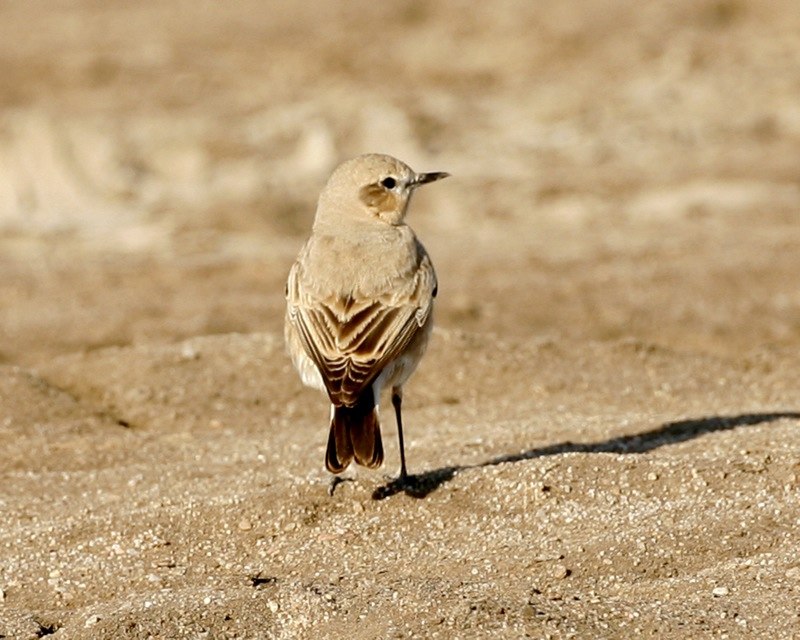
The Isabelline Wheatear is a small passerine bird belonging to the Muscicapidae family. It can be found in steppes and open countryside, breeding from southern Russia through Central Asia all the way down to northern Pakistan.
During wintertime it migrates southwards for warmer climates. Its diet mainly consists of insects which makes this species an insectivorous one.
Its usual hunting ground is on low vegetation or on bare soil where it searches for food with its agile movements and sharp bill.
The males are distinguished by their grey upperparts, light underside with buff markings around wings and tail as well as their white brow stripe that gives them their name: “Isabellina”.
Scientific classification:
| Kingdom | Animalia |
| Phylum | Chordata |
| Class | Aves |
| Order | Passeriformes |
| Family | Muscicapidae |
| Genus | Oenanthe |
| Species | O. isabellina |
48. Desert Wheatear
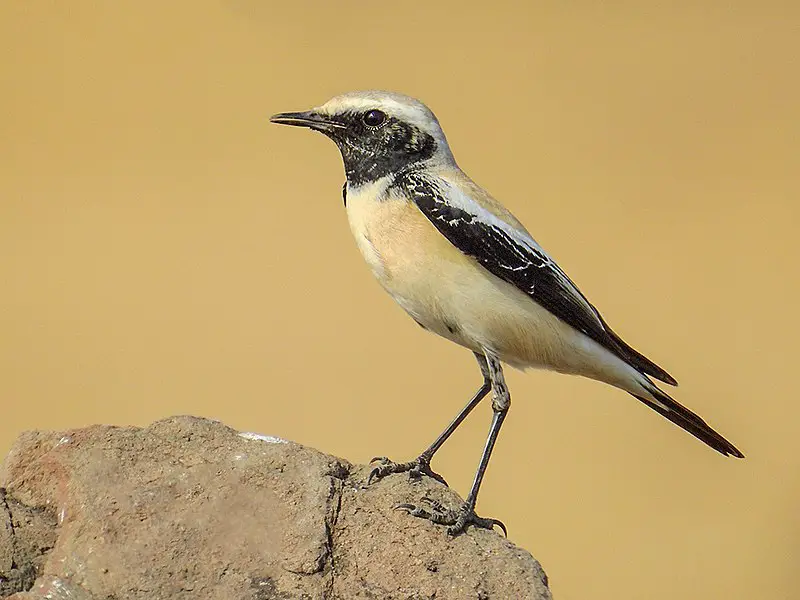
The Desert Wheatear is a small passerine bird that typically inhabits desert and semi-desert areas. It measures 14.5 to 15 cm in length, making it slightly larger than most thrushes but smaller than many Old World flycatchers.
The upper parts of this species are greyish-brown with black streaking, while the underparts are whitish or buffy white with some cinnamon on its sides and flanks.
Its tail has two prominent white bars at the tip which contrast starkly against its otherwise dark plumage.
During breeding season males will often display their conspicuous orange throat patch as part of courtship behaviour towards females of the species.
However, outside of mating season both sexes share identical plumages without any discernible differences between them apart from size variations common among all birds.
This insectivorous species mostly feeds on flying insects such as moths, beetles and bees that they catch midair during short sallies out into open spaces near coverts where they can hide if threatened by predators like other birds or mammals roaming their habitat range throughout Eurasia including rare vagrants to western Europe.
Scientific classification:
| Kingdom | Animalia |
| Phylum | Chordata |
| Class | Aves |
| Order | Passeriformes |
| Family | Muscicapidae |
| Genus | Oenanthe |
| Species | O. deserti |